Kenya, 2011
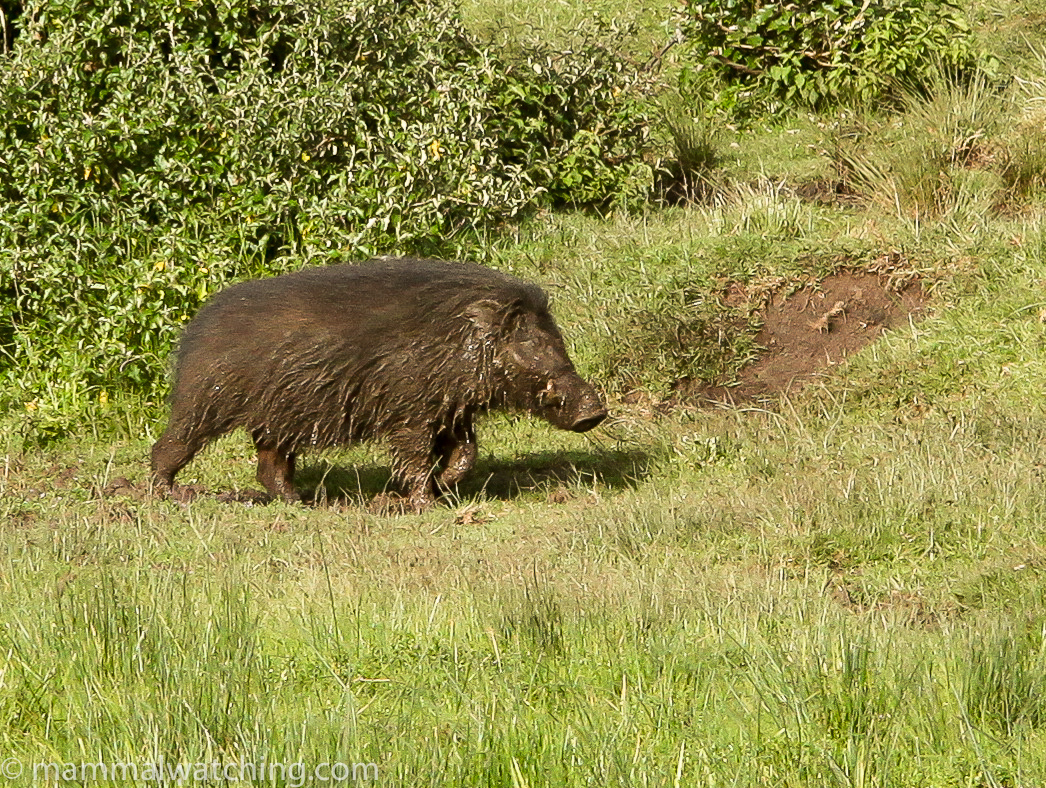
Giant Forest Hog, Hylochoerus meinertzhageni, Aberdare National Park
Kenya, more than any other country, is responsible for my interest in mammals, even if I hadn’t been there before 2011. Rather, I grew up in the 1970s watching wildlife documentaries on TV most of which I remember as coming from Kenya. And I also loved the show Daktari, which was about a Kenyan vet – well I imagined he was Kenyan at least. So from a very young age I can remember begging my Dad to take me to Kenya. He said he would. He never did. And it wasn’t until November 2011 that I got there.
My Kenya Airways flight from Bangui to Nairobi was fine. Their onward connection was a farce. It was scheduled to leave Mombassa at 20.00. The incoming plane was late. ETD 21.00. We took a bus to the plane and en route they discovered a technical problem with the aircraft. Back to the terminal. We finally left at midnight after a frustrating but amusing few hours. Several passengers decided to harangue the airline staff. A crowd gathered around them to video the scene which was really very entertaining. When, finally, we were led onto the tarmac it became apparent the Kenya Airways guy leading the charge did not know which aircraft we were heading for. So 200 people were led backwards and forwards across the tarmac doing the runway conga. The queue was strung out so, after each U-turn, we ploughed into the tail end of the line. We even went up the steps to the wrong plane. Twice.
God knows how many people missed the flight (or how many arrived in Mombassa expecting to be somewhere else). Chaos above and beyond even EasyJet’s levels of incompetence (a phrase that I once thought inconceivable). When we finally made it to Mombassa I took a cab to the Serena Beach Resort, a palace of a hotel which I had hoped to enjoy for more than the few hours I did. It was pleasant to scratch my Central African insect bites in comfort.
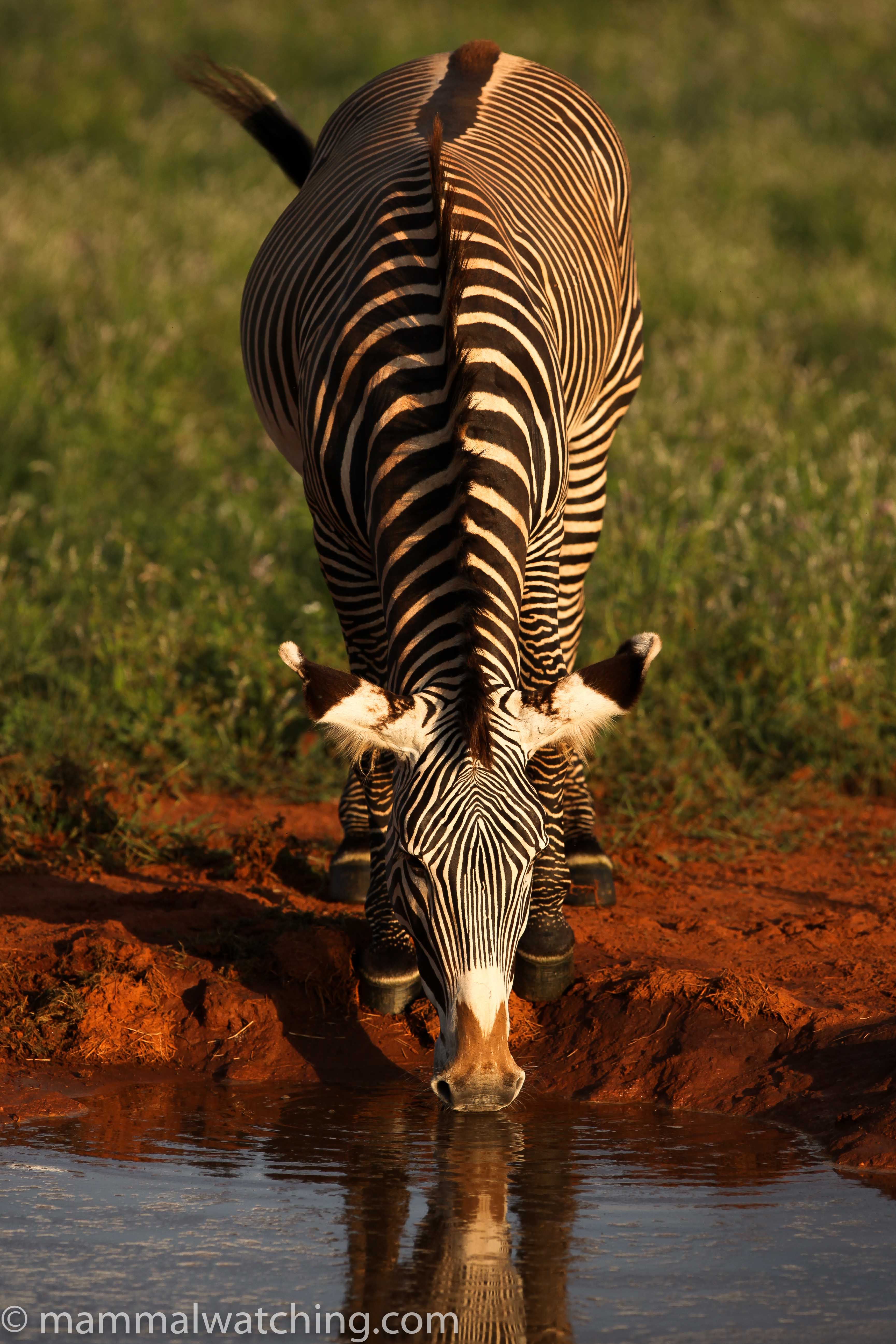
Grevy’s Zebra, Equus grevyi, Samburu National Park
I traveled around Kenya in a car from Erikson Rover Safaris. They have a fleet of old but well maintained Land Rovers and Range Rovers. They can supply camping equipment and also offered me a driver (check – useful if you want to sleep during the day and also invaluable for spotlighting, though it turned out we couldn’t actually spotlight in any of the parks) and a cook (check – useful if I didn’t want to live off tins of beans for a week, my usual camping menu ). The people at Erikson’s were good to deal with and it is a relatively cheap way to travel around. However I forgot how much petrol Range Rovers guzzle. They use an insane amount of fuel and I would have been much better hiring a slightly more expensive diesel Land Rover. Sadly they don’t have any Toyotas. John the driver, and Juma the talented cook, were both friendly, reliable people and I was glad to spend the week with them.
Arabuko-Sokoke Forest National Park
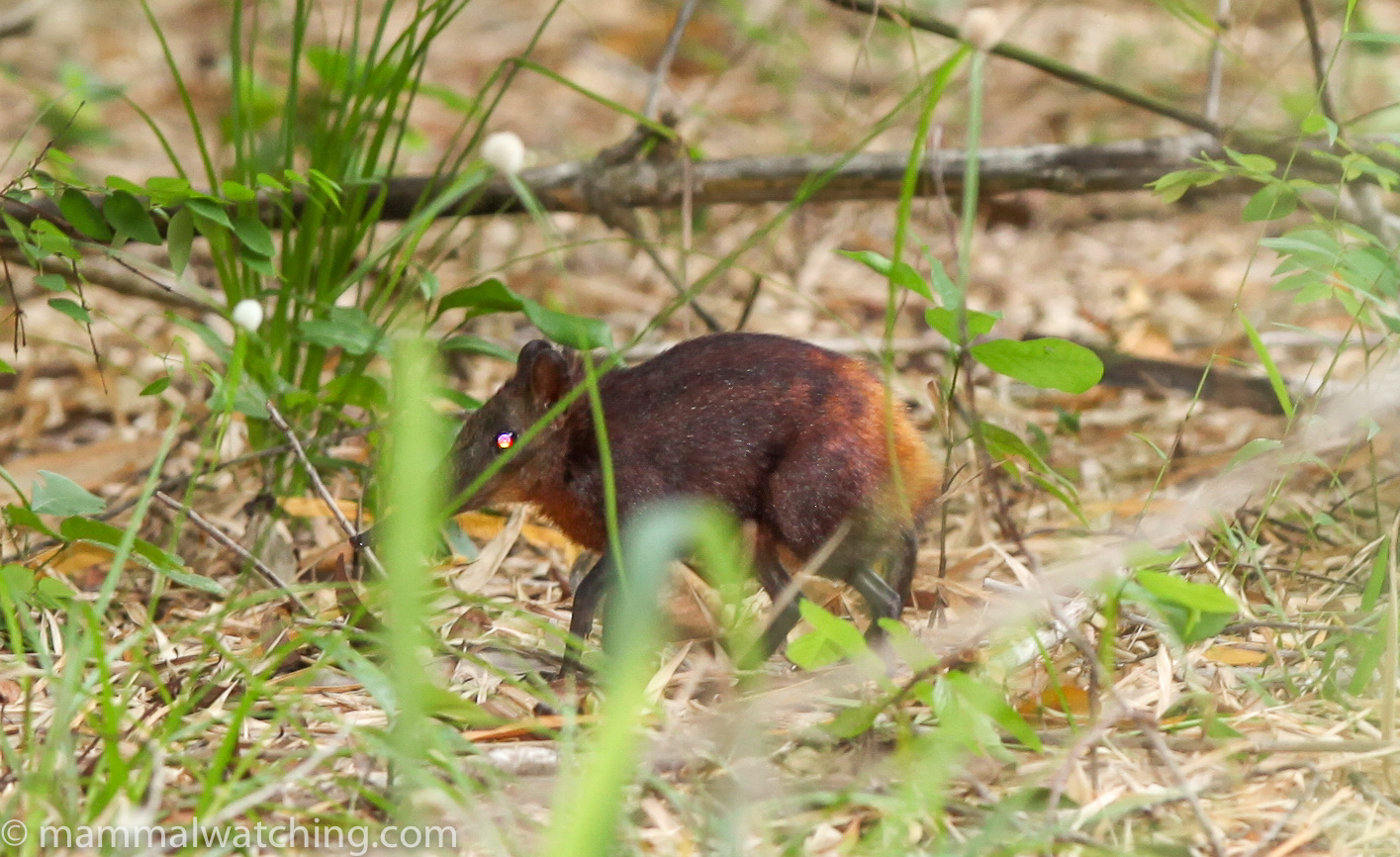
Golden-rumped Elephant Shrew, Rhynchocyon chrysopygus, found only in Sokoke Forest.
Compared to the Central African Republic, the drive from Mombassa to Gedi and the Sokoke Forest was closer to Florida than Africa. I exaggerate … but it is one of the more developed bits of Africa I have seen, where the bar & grills come with Wifi and happy hours.
The Sokoke forest is less than 2 hours north of Mombassa and one of the last remaining tracts of an ecosystem that used to stretch a long way down the coast. It is home to some very nice mammals and top of my want list was the Golden-rumped Elephant Shrew. We set up camp and I hired a local guide Johnson M Kafulo who was waiting for business outside the park. I have no idea what the other guides are like at Sokoke, but Johnson was pretty good, especially at finding several of the species I was chasing. I would use him again if I went back.
We began with a visit to Pangayamba Cave, where I was told there were many bats. It is signposted from Gedi Village as a tourist attraction. I’m not sure why any tourist would visit. It is a not very interesting cave though it does have a wooden bench inside and a mask from when a witch doctor set up shop there in the 1970s. But it was home to a small colony of Heart-nosed Bats. A really nice species that I hadn’t seen before.
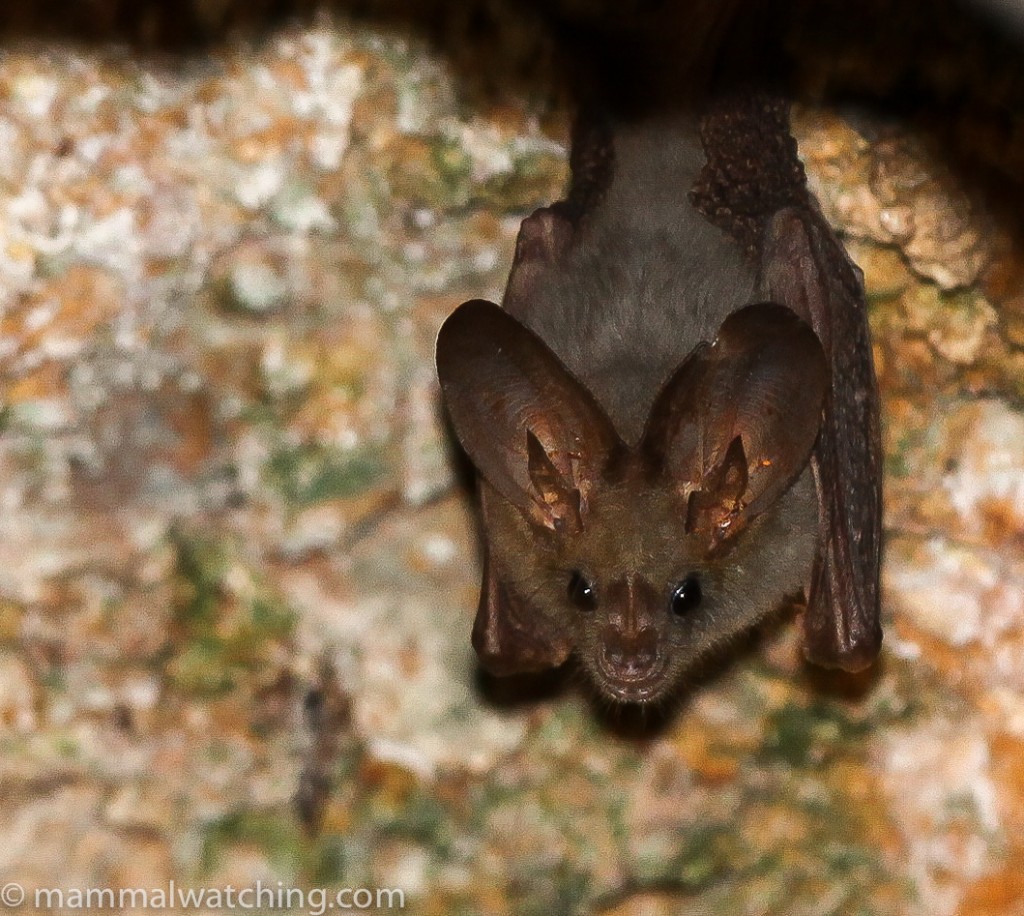
Heart-nosed Bat, Cardioderma cor
We were camping at the main gate. There are several campsites in the forest and this was probably not the nicest, and certainly not the quietest, but it seemed to be in the best area for the Golden-rumped Elephant Shrews. Johnson quickly spotted a pair feeding in a thicket next to camp. We had good views through the undergrowth of this fabulous animal. A few minutes later I spotted another out in the open amidst stands of bamboo.
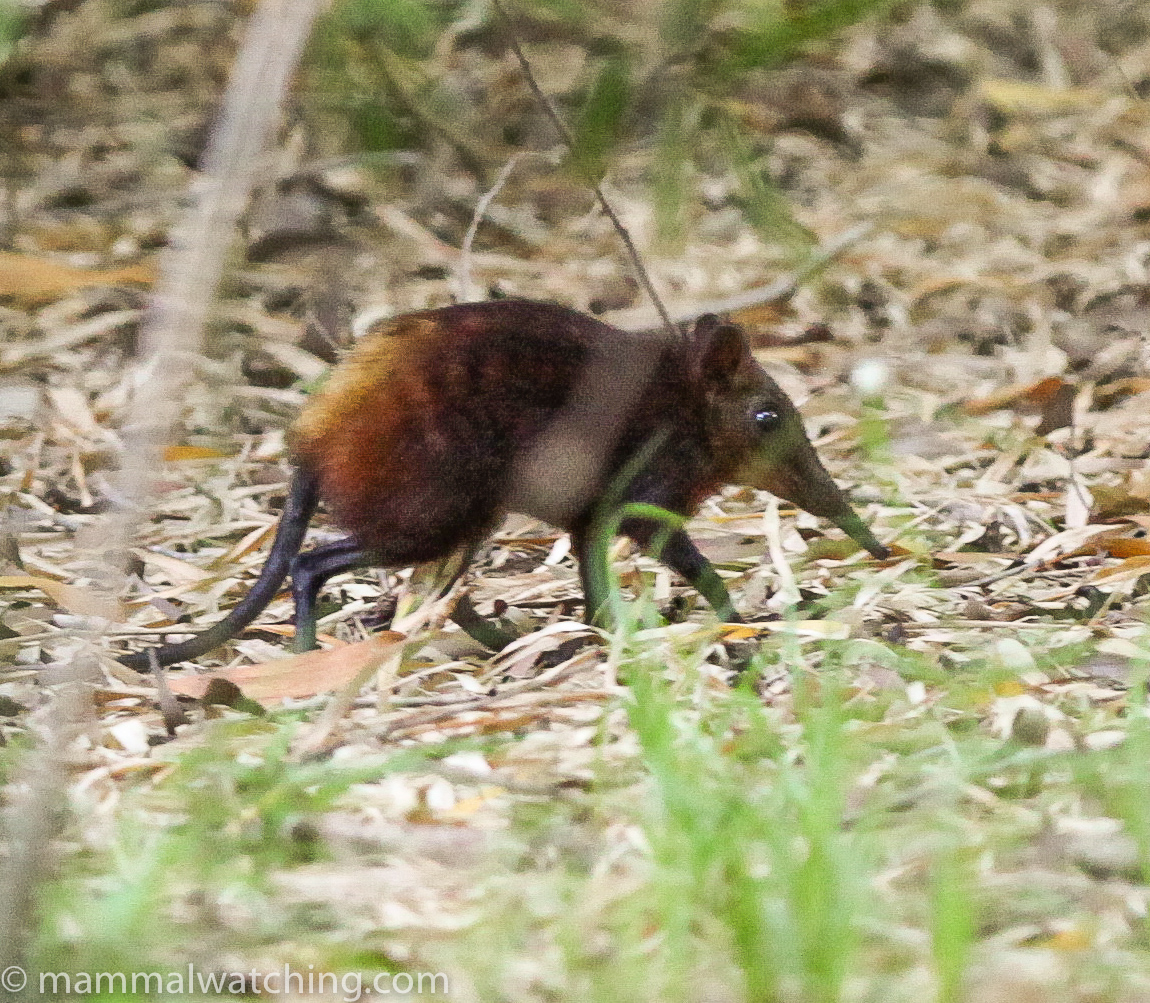
Golden-rumped Elephant-Shrew, Rhynchocyon chrysopygus
In the late afternoon we drove a kilometre or two into the forest to look for squirrels and saw a Zanj Sun Squirrel (I presume though it looked a lot like the Red-legged Sun Squirrels I had been looking at a few days earlier in Central Africa) and several of the pretty Red-bellied Coast Squirrels. The area is also good for Four-toed Elephant Shrew and we heard a couple rustling and giving their foot drumming alarm but couldn’t see them. Blue (Sykes’) Monkeys are very common around camp and in the forest. We also saw a troop of Yellow Baboons.
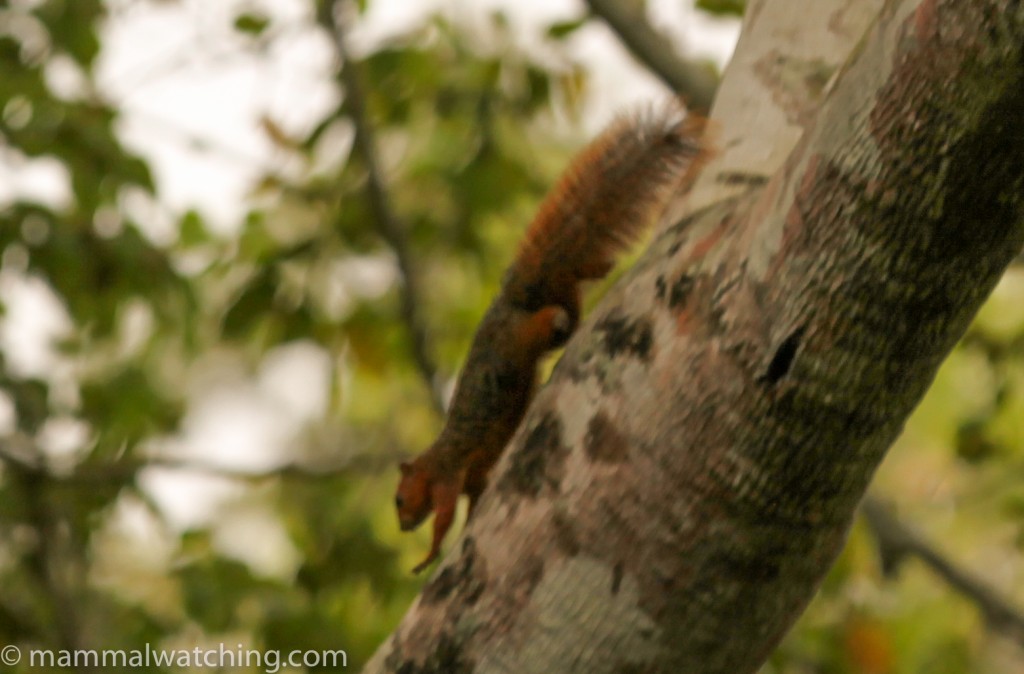
Red-bellied Coast Squirrel, Paraxerus palliatus
Walking back to camp in the dark we looked for Galagos: both Northern Greater Galagos (Otolemur garnettii) and Lesser – presumably Senegal – Galagos) are here. We heard both calling but couldn’t spot either. Back at camp, John and Juma had had a pair of Lesser Galagos jumping around the tree right above where they were sitting. I couldn’t find them but did see at least one Greater Galago near camp that was very vocal.
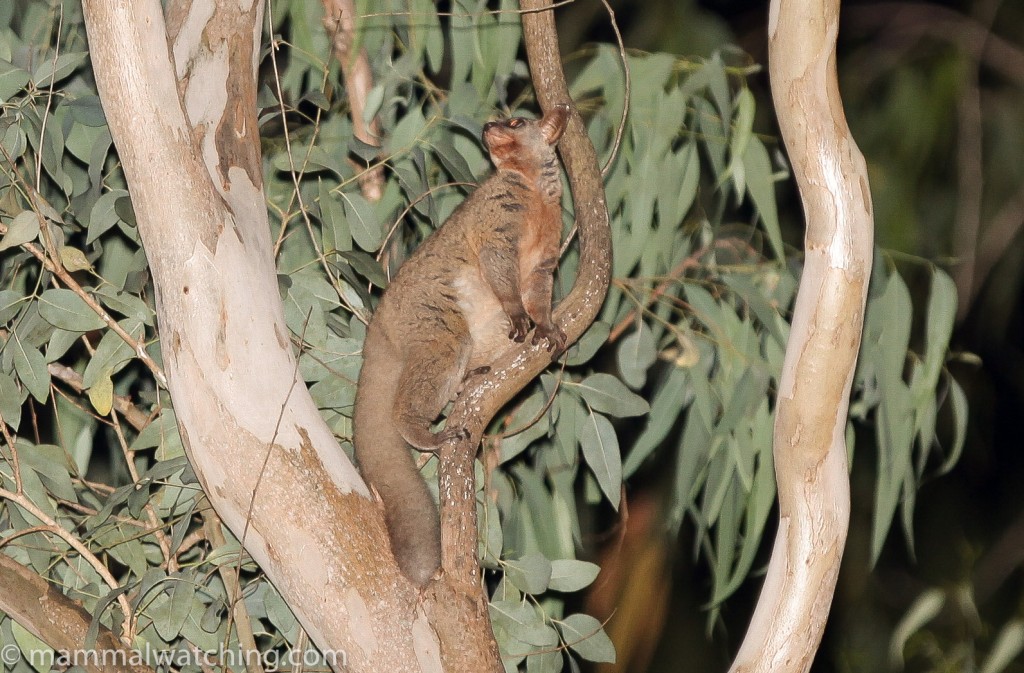
Garnett’s Greater Galago, Otolemur garnettii lasiotis
In the morning Johnson and I headed further into the forest to look for Ader’s Duikers and another Elephant Shrew species which he said was Round-eared but was presumably one of the Sengis. We drove through the Mida Gate along the road to the viewpoint at 6.15am, stopping to talk to one of the park researchers who was walking along the road. He’d just seen a Sokoke Dog Mongoose – a species I derided not to bother looking for when Johnson told me he hadn’t seen one during 7 years working in the park. This I then realised was a function of his not being in the right areas after dark. If I go back I would try to find this interesting species.
When we got into the red soil country we left the car and walked for over 3 hours through Duiker habitat. Judging by the number of tracks they are quite common. We heard at least 4 animals (Johnson got split second glimpses of two, and the other two made alarm calls). A number of other rustlings may also have been Ader’s Duikers. Or they may have been Four-toed Elephant Shrews, which are also abundant judging by the number of tracks we saw.
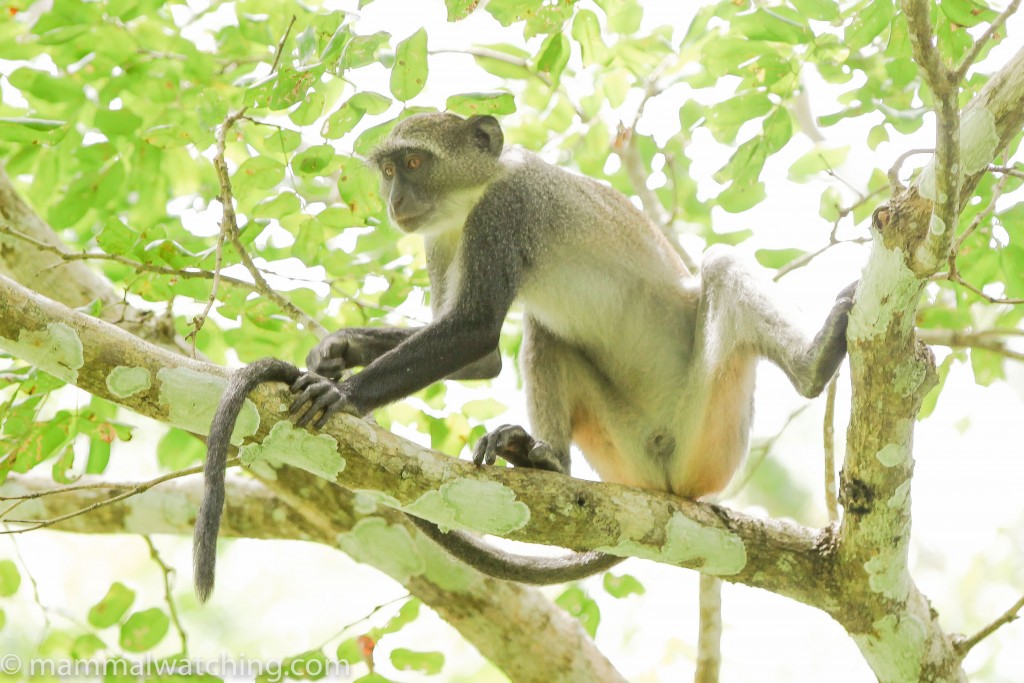
Blue (Sykes’s) Monkey, Cercopithecus mitis albogularis
Caracals and Aardvarks are two other nice species that are probably not terribly hard to find after dark in this area. Although we had heard lots we didn’t see anything so at 10am we headed to a section of the forest known as the Sokoke Scops Owl site, another area heavily used by Duikers. There were very fresh tracks and droppings all around and we heard more animals but couldn’t spot them. They are super-wary and so I think the best technique would be to sit at a spot like this and wait for a couple of hours to look for them.
After packing up camp we visited another cave we had heard about, which some locals called the Ali Baba Cave. It was along the road past Jimbu Primary School and took some finding (most of the locals claimed never to have heard of it but I think that was because they didn’t trust strangers). We found it eventually. It was much more impressive than Pangayamba Cave. And though it didn’t contain many bats the two species I saw were both new for me: a few African Sheath-tailed Bats and a handful of Egyptian Rousette Fruit Bats (not Angolan Fruit Bats as I thought initially).
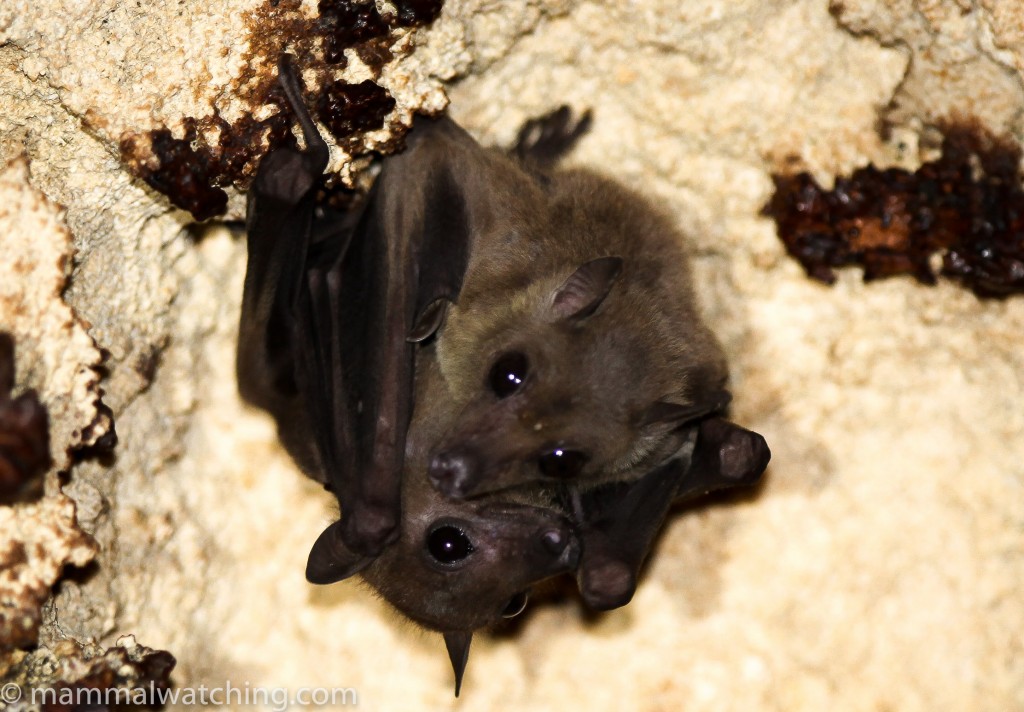
Egypitan Rousettes, Rousettus aegyptiacus
By 2pm it was stinking hot. Probably too hot to see the “common tree squirrels” – Ochre Bush Squirrels I guess – that Johnson said were best seen around the Gedi ruins. So we set off for Tana River.
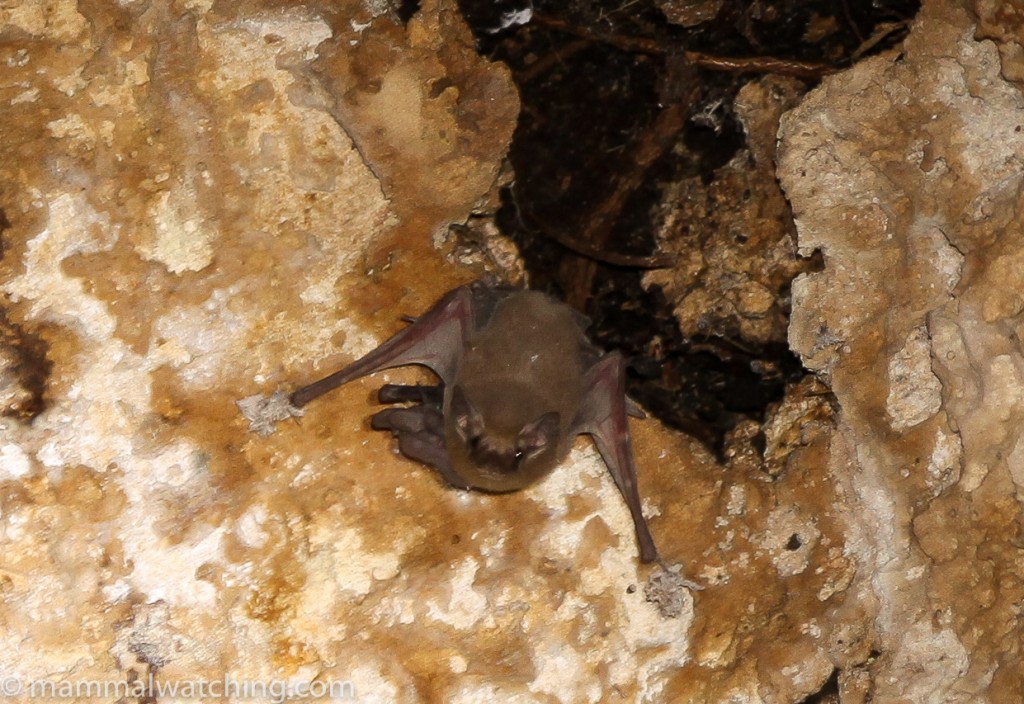
African Sheath-tailed Bat, Coleura afra
Tana River Primate Reserve
It is about 200km from Gedi to the Tana River Primate Reserve. The road was crappy but we had good directions as neither John nor Juma had been there before. At the last police checkpoint before Hola we were told to drive 55 kms and turn right at the signboard. We hadn’t counted on road construction workers taking down the signboard that day. I hadn’t counted on John not having a map and not realising his odometer was in miles and that they are different to kilometres. All of a sudden Kenya was starting to feel more African.
We overshot the turn by 60km and, after many phone calls in Hola, it was gone 7pm by the time we finally arrived at the Kenya Wildlife Service (KWS) base camp near the Primate Reserve. We’d seen troops of Baboons and one troop of Vervet Monkeys along the road from Malindi, as well as a Spotted Hyena crossing the road at dusk between Hola and the Reserve.
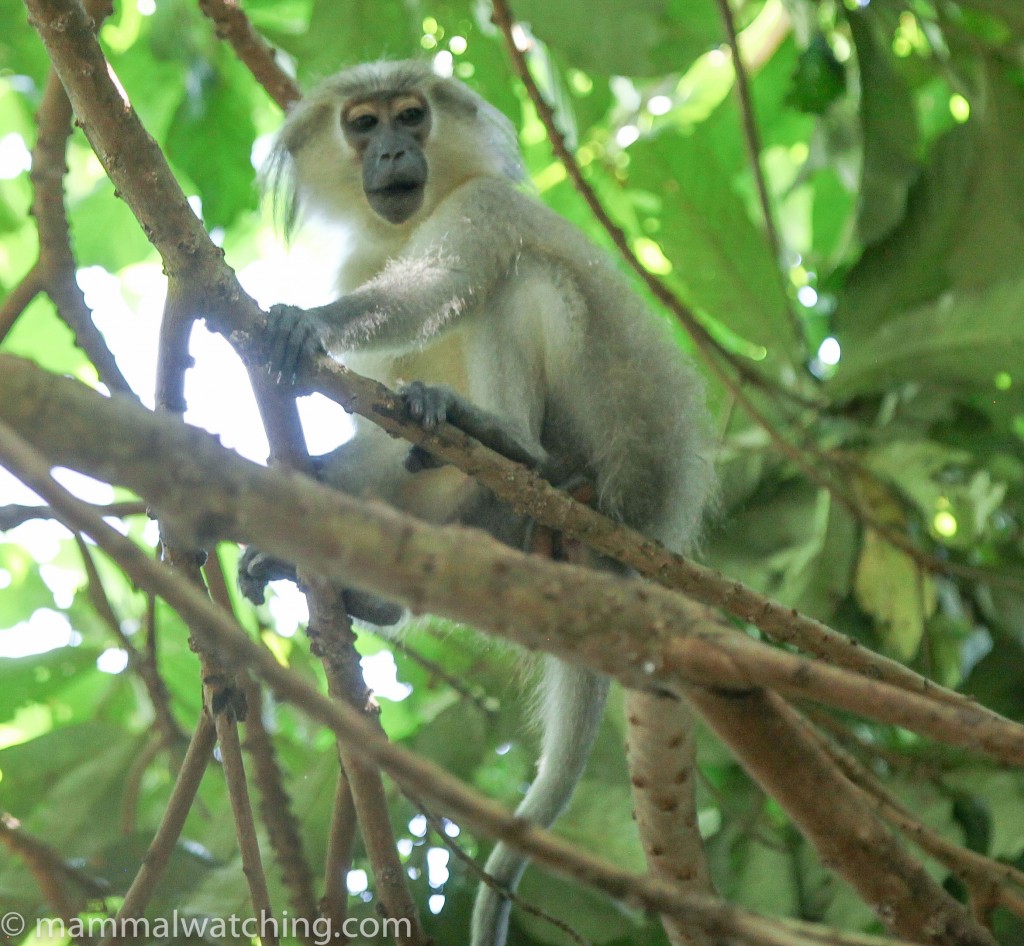
Tana River Mangabey, Cercocebus galeritus
The Primate Reserve was another 7km from base camp and the KWS suggested we ought to wait until morning before trying to drive the road in case we got stuck as it was muddy (this – it turned out – was something of an understatement). There didn’t seem much point in setting up our tents so we found an empty KWS staff house to sleep in. Big mistake. It was stinking hot inside, and I’ve never had so many bugs crawl, drop and wriggle onto me as I did that night. I started off on a mattress on the floor then retreated to a flea-ridden bed in the vain hope the mosquito net would help. The net’s mesh was so large that a small bird could have entered, and yet in the morning it was still sagging from the weight of a thousand bugs. The other 10,000 were on my mattress. And on me. I lay awake most of the night, swatting the invading hordes and hoping Malarone was effective.
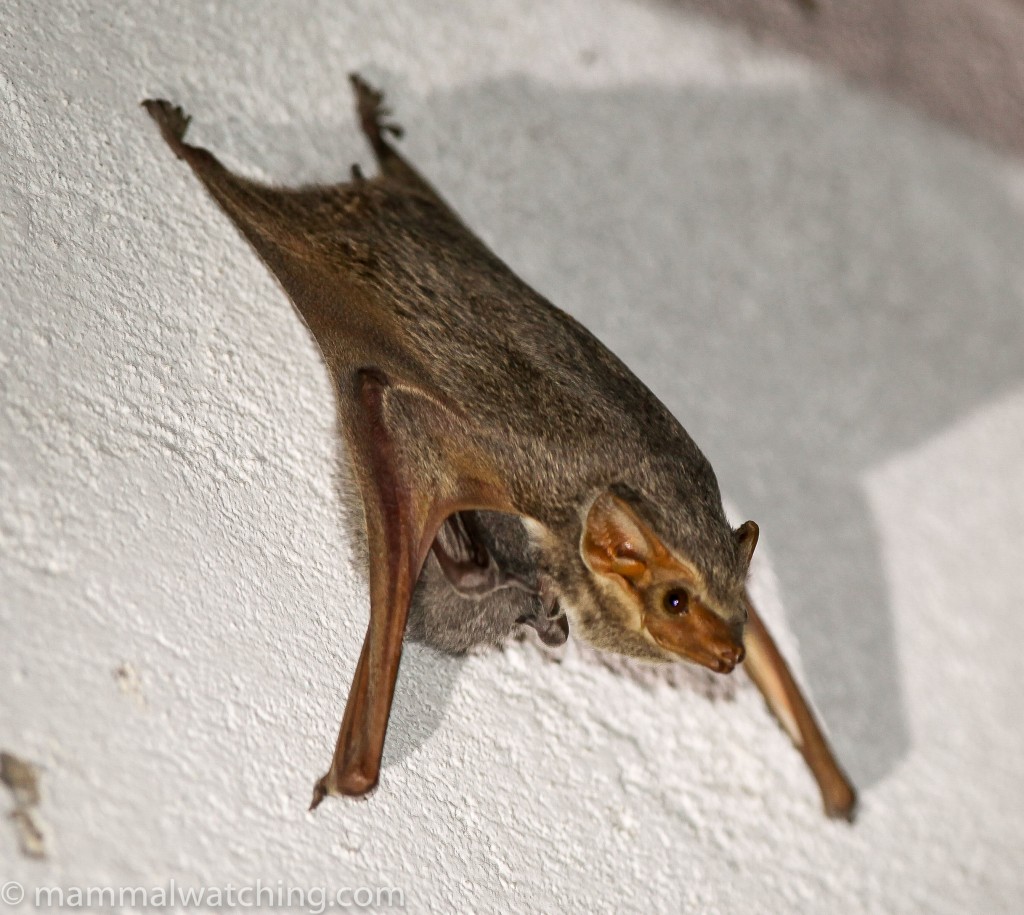
Mauritian Tomb Bat, Taphozous mauritianus
The only consolation that night was seeing a few Mauritian Tomb Bats roosting under the eaves of the house. They were quite strikingly coloured for a Taphozous: pure white ventrally and some had chestnut backs.
The next morning the KWS were more forthcoming about the road. It was impassable. They hadn’t been along it for 3 weeks. When I asked if we could try a motorbike they agreed we could try though weren’t sure even that would get through. So three of us – me, the bike’s rider and a KWS guide with a gun – set off. I’m not sure why we needed the guy with the gun. I think mainly in case we ran into Somali bandits (my driver for instance was really quite nervous about the security in this area which is close to Somalia).
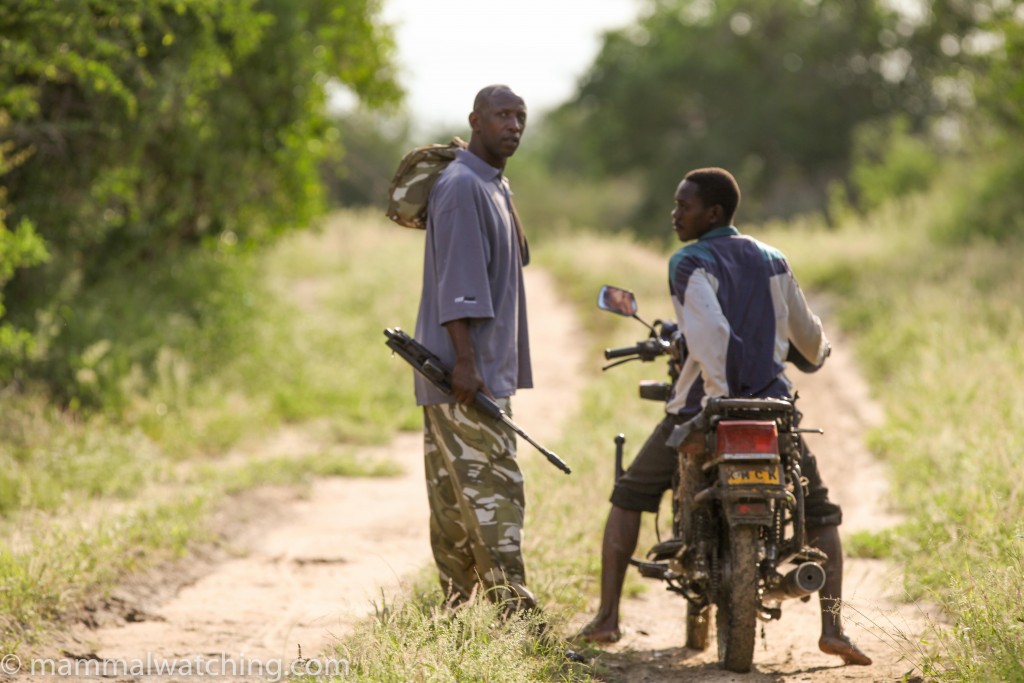
To Tana!
After a few hundred metres it was clear we couldn’t take the direct route to the Primate Reserve. Where once was a road, there now was a swamp. So we took a long circular detour and arrived at the camp 2 hours later. A good portion of which was spent wading through thigh deep water and ankle deep mud (some black soil patches were almost impossible to walk through let alone get a car through).
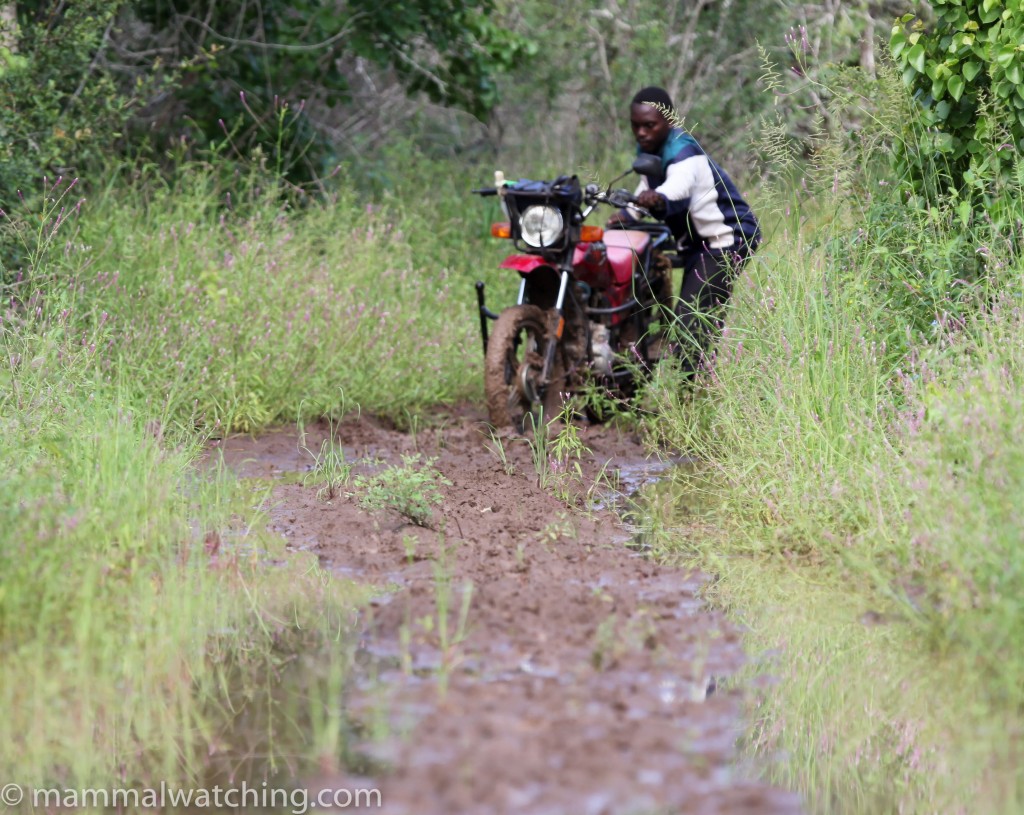
Spot the road….
There were several pairs of Dikdiks (I believe now called Hinde’s) near the KWS base camp but we didn’t see any other mammals on the way.
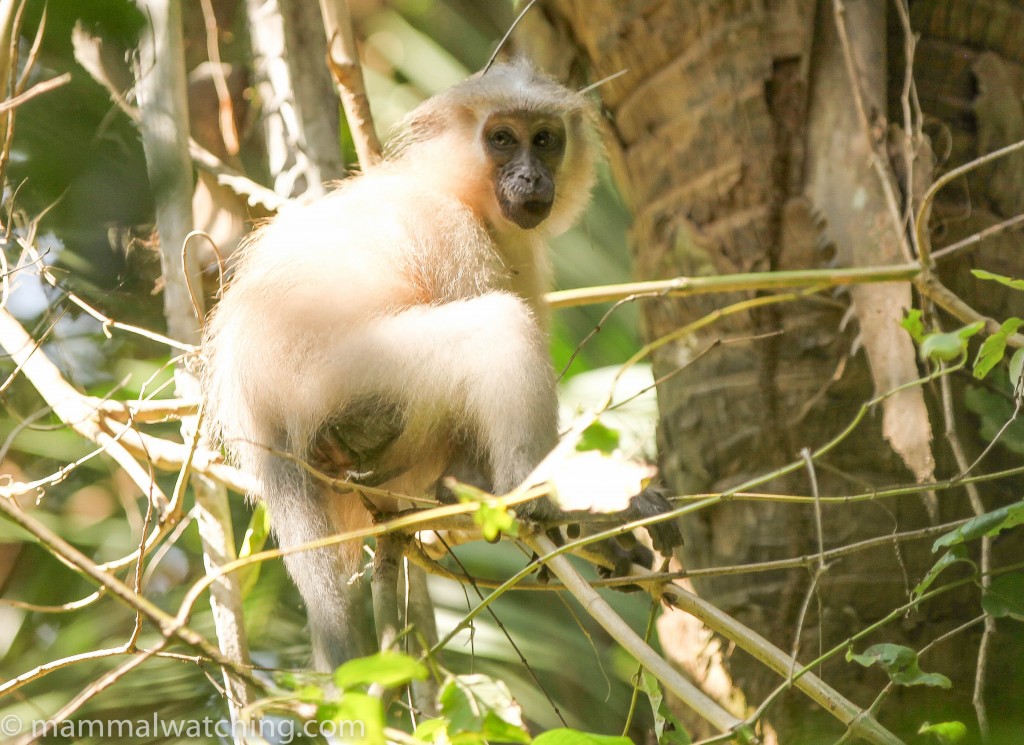
Tana River Mangabey, Cercocebus galeritus
The Tana River Primate Reserve is a stretch of riparian forest and is the last home for Tana River Crested Mangabeys and Tana River Red Colobus Monkeys. The Mangabeys were easy to see around the camp, and one of the camp staff found me a few Red Colobus within 30 minutes. We also saw Blue Monkeys and Yellow Baboons and I had a nice look at a Harvey’s (now lumped in 2022 with Natal Red) Duiker though it didn’t look all that much like the picture in Jonathan Kingdom’s field guide – it had black legs for starters – though this species are quite variable apparently.
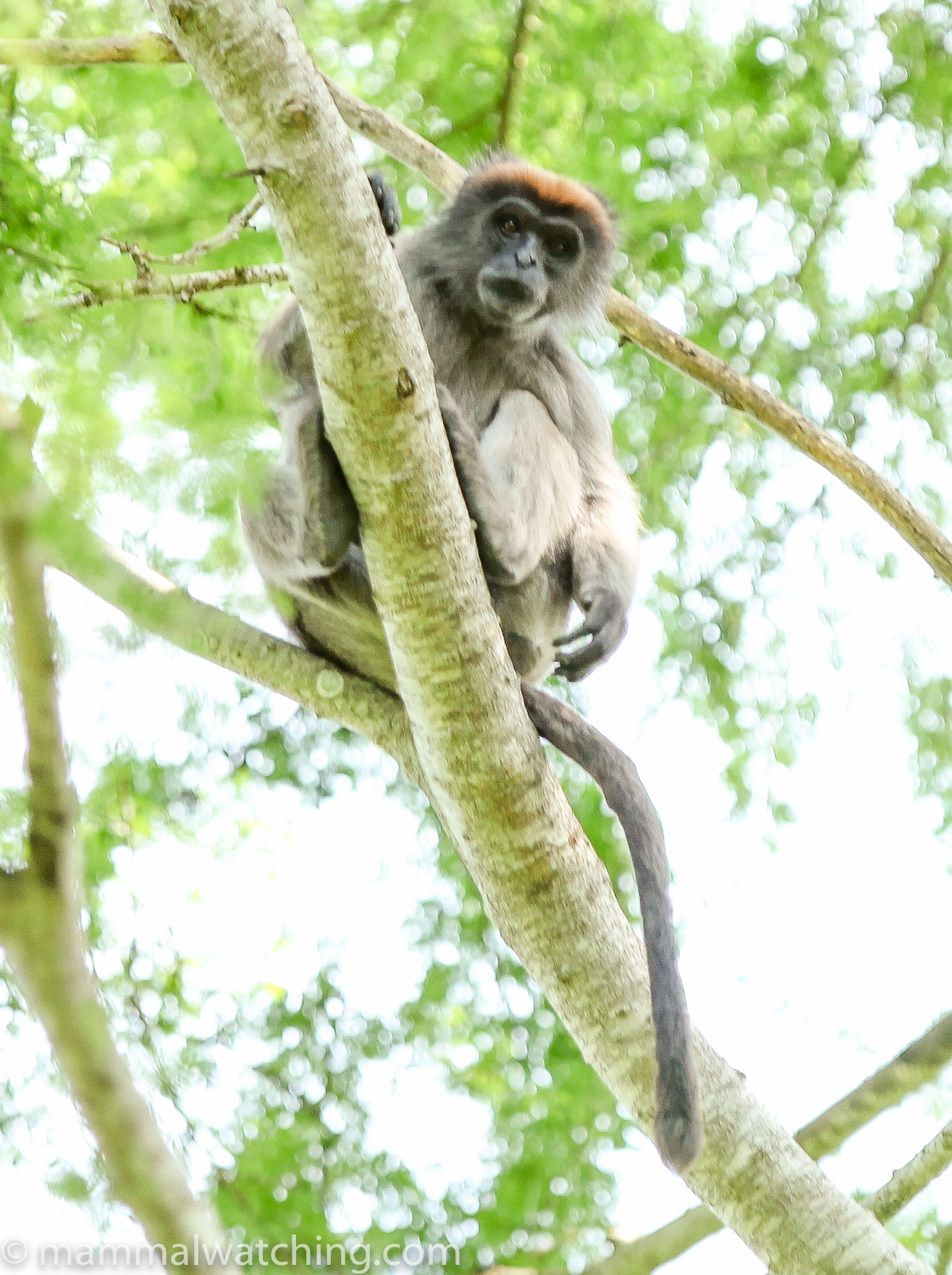
Tana River Red Colobus, Piliocolobus rufomitratus
I’d hoped to cross the Tana River to visit the Hirola Sanctuary – Ishaqbini – on the other side. Charles Foley, from the Wildlife Conservation Society in Tanzania, had put me in touch with Gwili Gibbon who works with the Hirolas there. Gwili was keen for me to get over, but warned that the road into the reserve from the Tana Camp side might be tricky (I was advised it was impassable). Crossing by boat from the reserve could have been another option but the KWS boat had engine problems and even if I could have rowed across the river I suspect the roads on the other side were even worse than in the primate reserve. So I reluctantly gave up on the Hirolas and Desert Warthogs which are also at Ishaqbini. Conscious of the time, the heat, and the long muddy motorbike ride back to the car, I left.
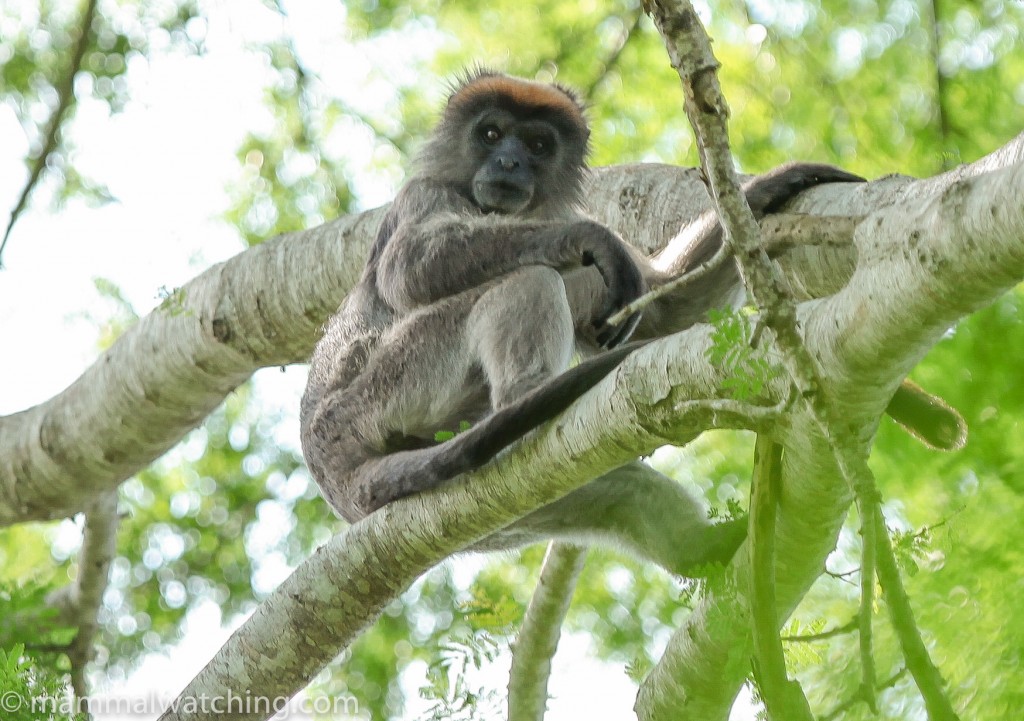
Tana River Red Colobus, Piliocolobus rufomitratus
The ride back – on a different route – was a little quicker but no less muddy. By midday we were driving north towards Samburu.
The highway from Tana through Hola and towards Gerissa was tarmac but severely potholed (or was it potholed and mildly tarmaced?) so we made slow slow progress, getting to Gerissa and the junction of the major A3 by about 5pm. The only mammals en route were my first Unstriped Ground Squirrel and a pair of Dikdiks (Kirk’s I believe).
I had hoped to get to Meru National Park that evening (where Crested Porcupines are regular visitors to the campsite I was told) but by 7pm we were still at least 3 hours from Meru, an the car had an electrical problem. In the afternoon the ignition had stopped working. As the sun set we realised we had lost the headlights too. Presumably the jarring from the potholes had loosened a connection, but it took 2 hours to fix so we gave up for the day and stayed in the town of Mwindi where a hot shower, a lack of heat, humidity and bugs (other than a few tame cockroaches) made the Mwindi Cottage Hotel feel like the Intercontinental.
Samburu National Park
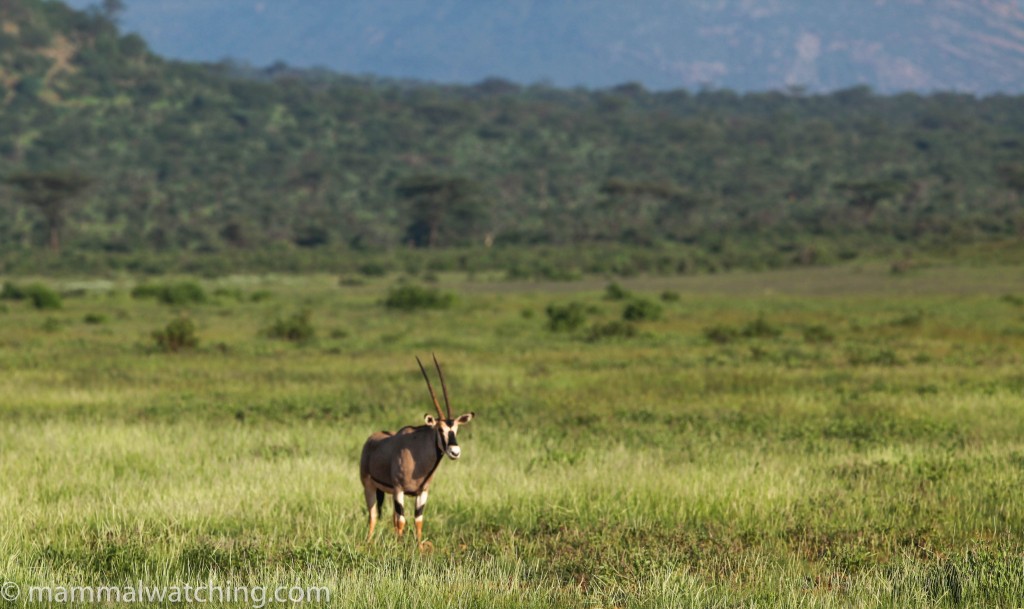
Beisa Oryx, Oryx beisa, Samburu
Samburu National Park was another 5 hours from Mwindi. It was blissfully cool up on the plateau between Mount Kenya and Aberdare National Park as we approached the park. Forty-five minutes later we had dropped down to the park entrance and it was stinking hot again. The park reminded me of Awash National Park in Ethiopia, and indeed it shares much of the same fauna.
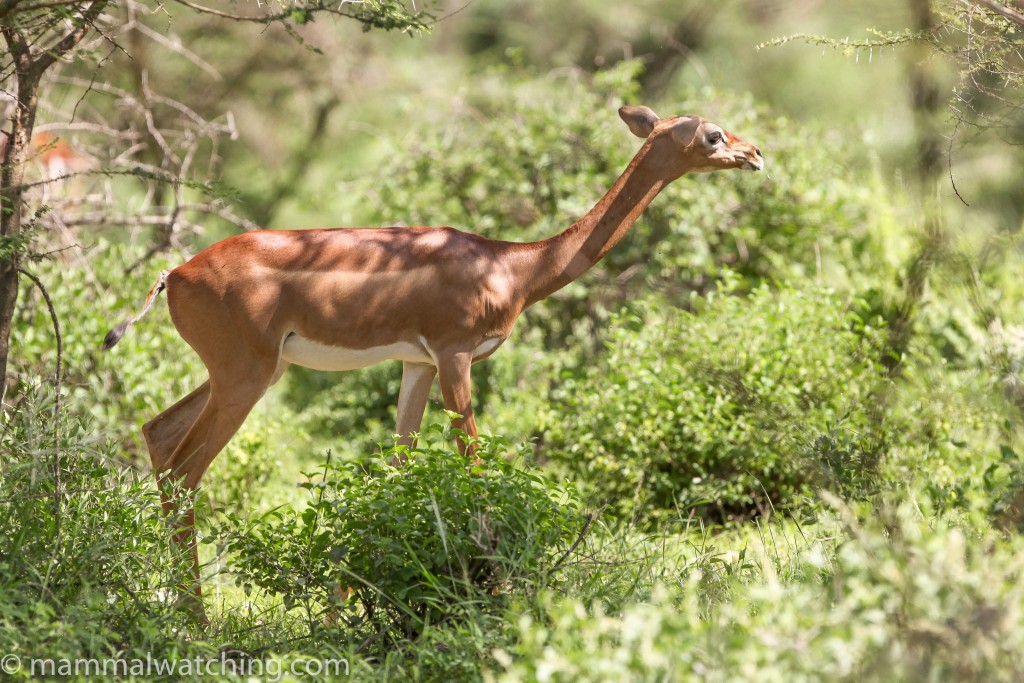
Gerenuk, Litocranius walleri
When we arrived John took me first to a small community run campsite just outside the park. It was a scorching dust bowl. Thankfully I asked whether there was camping inside the park. There was and the campsite there, alongside the river, was much much nicer. Samburu is usually very dry but there had been a big dump of rain in recent weeks and it was looking beautiful. There were a lot of animals around despite the rain but apparently fewer than usual.
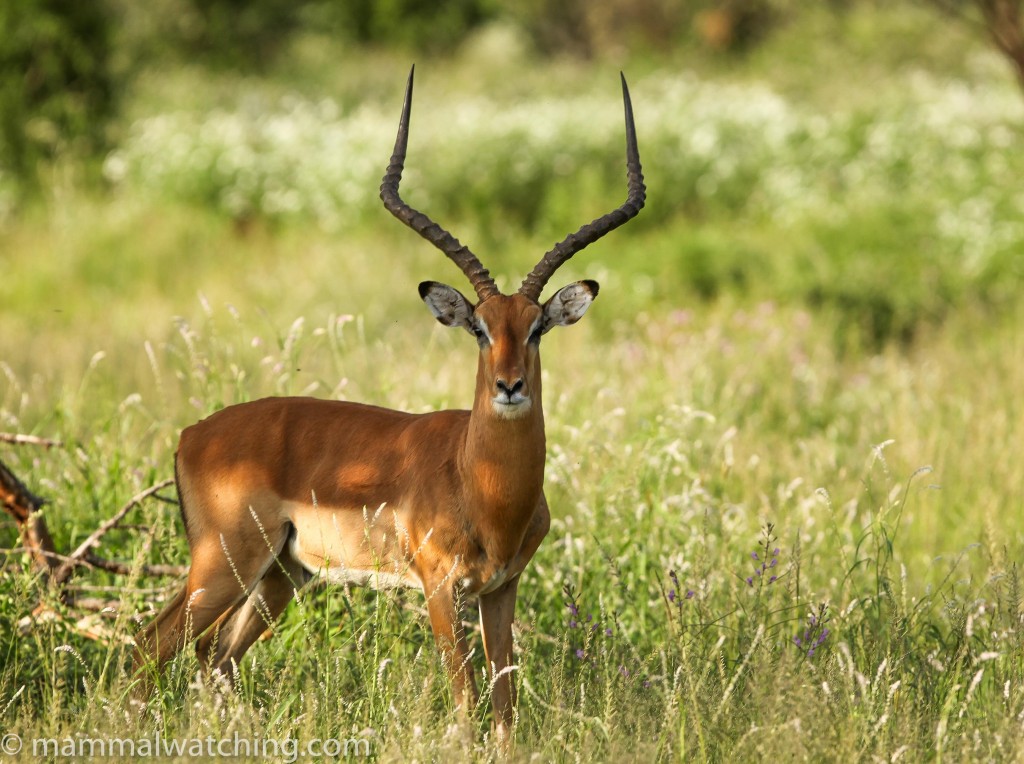
Impala, Aepyceros melampus
On the drive in, and during late afternoon and early morning game drives we saw mobs of Beisa Oryx, Elephant and Impala.
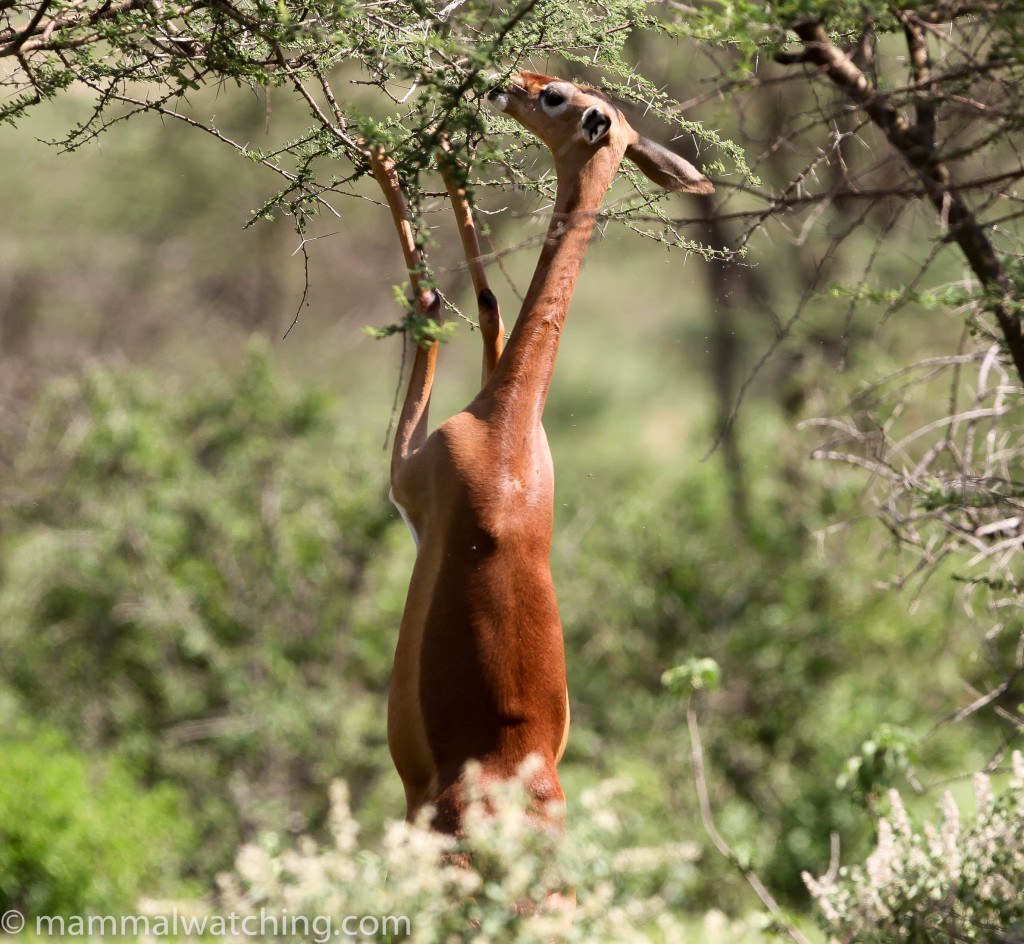
Gerenuk, Litocranius walleri
Gerenuks, one of the species I wanted to see here were also common as were Dikdiks. Both Kirk’s and Guenther’s Dikdiks occur in the park and are notoriously hard to tell apart. I must have seen over 50 pairs or threesomes while I was there.
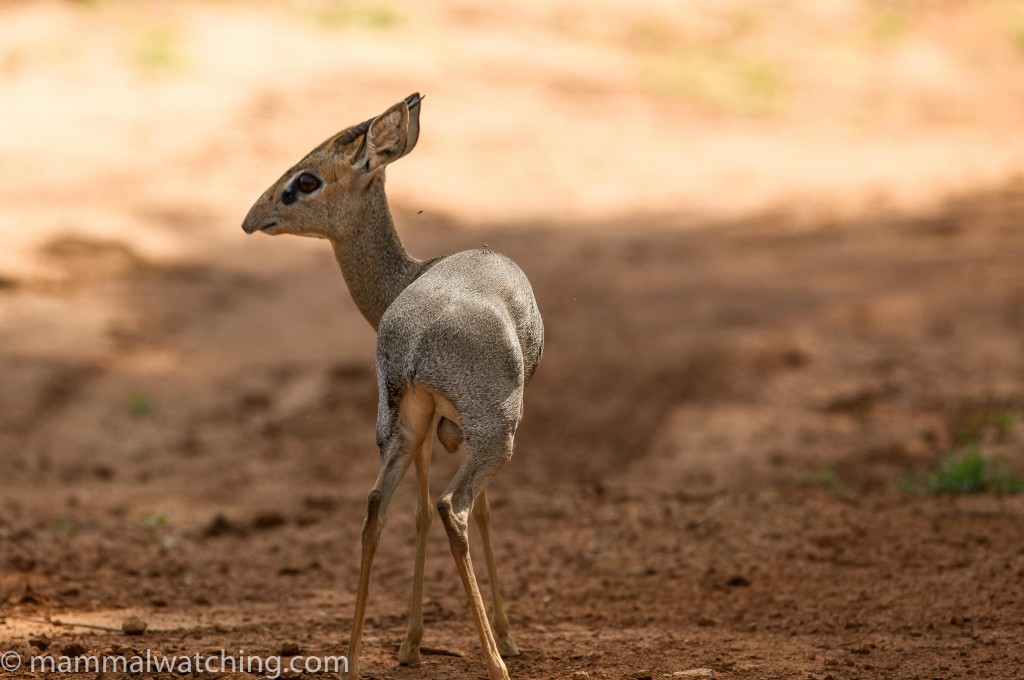
Guenther’s Dik-dik, Madoqua guentheri, and its longer snout.
I have it on good authority that Guenther’s have a longer proboscis, and that while Kirk’s Dikdiks can occasionally extend their nose to a similar length when the mood takes them, the Guenther’s have a permanent snout.
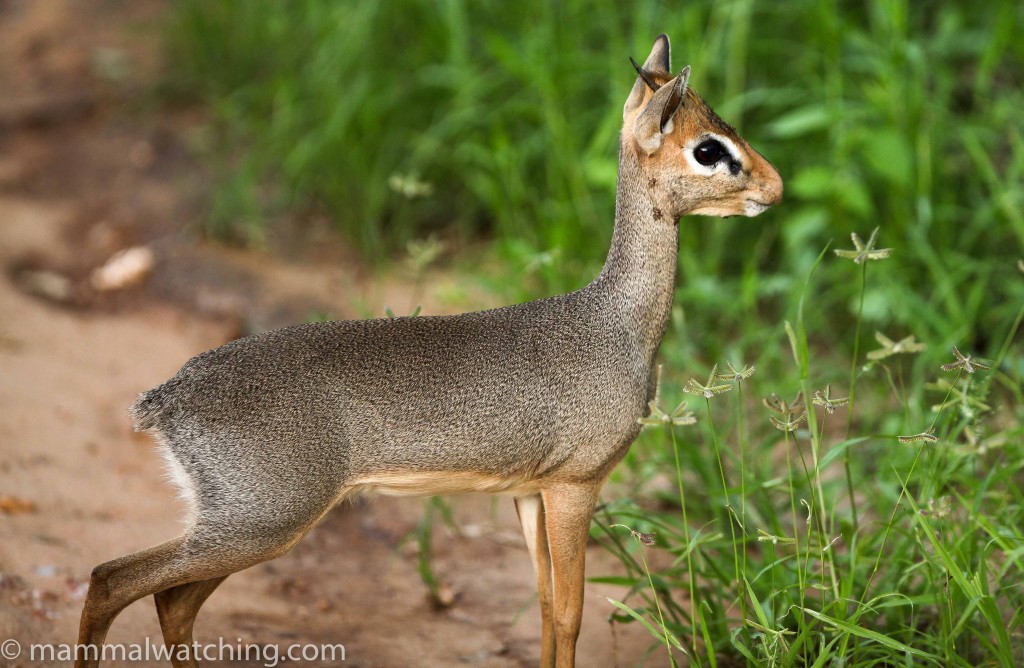
Kirk’s Dik-dik, Madoqua kirkii, and its shorter snout.
There were a few Bright’s Gazelles, Giraffes (Giraffa camelopardalis) and Waterbucks too along with several lone Grevy’s Zebra, the second of the key species here. Beautiful animals.
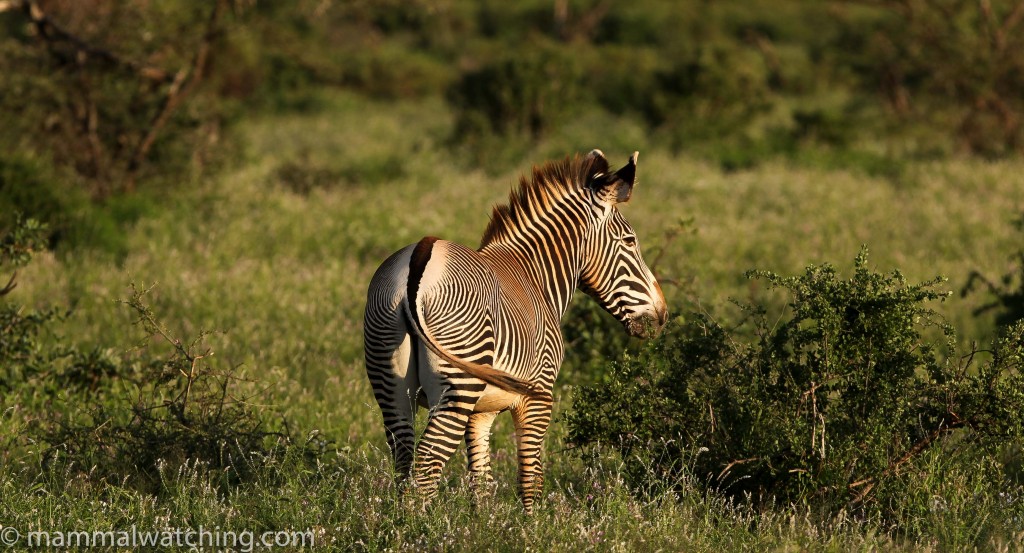
Grevy’s Zebra, Equus grevyi
Around camp there were Vervet Monkeys and Olive Baboons along with a party of Dwarf Mongooses (I thought perhaps that the Desert Dwarf Mongoose might occur here but I suspect it is not found so far south) .
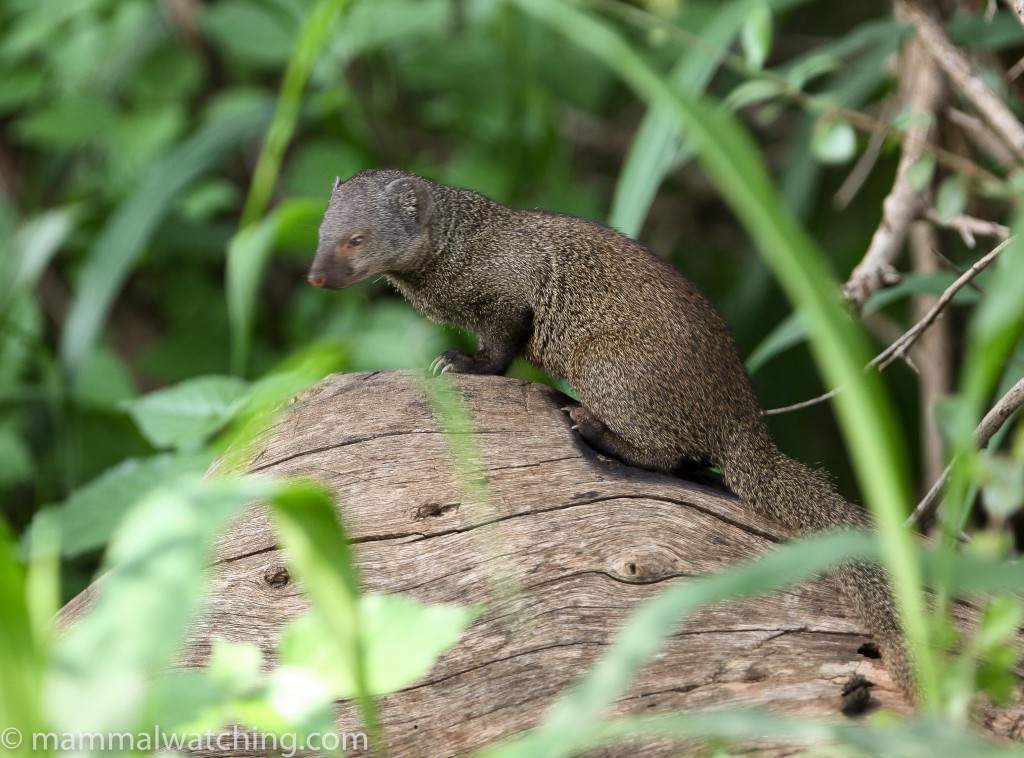
Dwarf Mongoose, Helogale parvula
At night a virtually tame Common Genet came to the campfire looking for food.
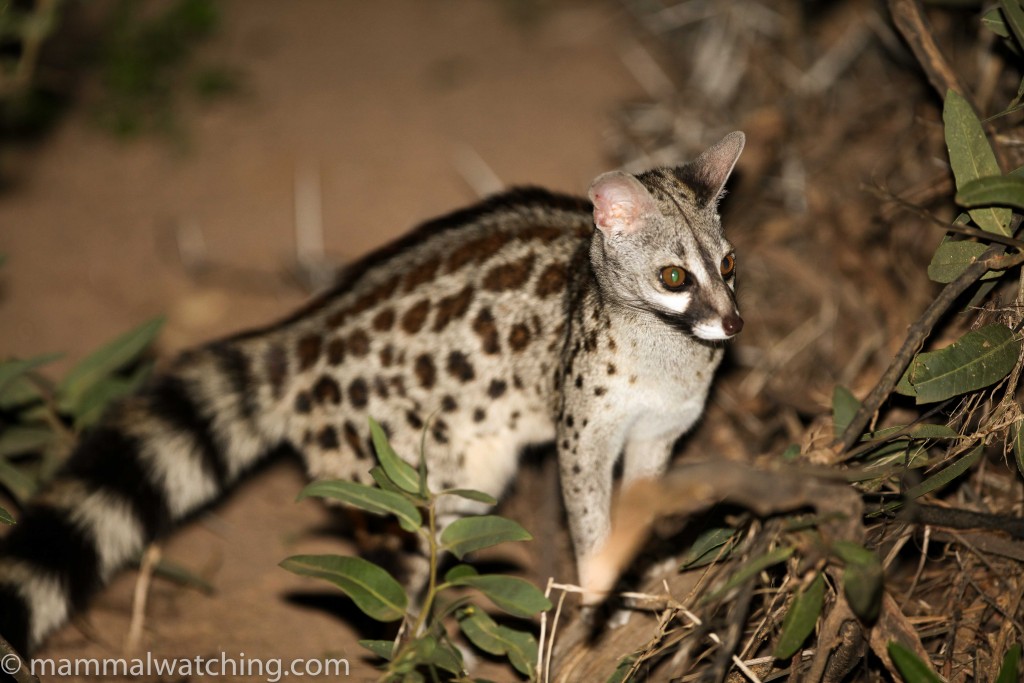
Common Genet, Genetta genetta
I went for a walk on my own until I found fresh Lion shit and headed back quickly. One of the rangers – living in the KWS camp next to my campsite – said Crested Porcupines rooted around the garbage there most nights. We looked at 9pm and again at midnight but couldn’t see any. However I did see a White-tailed Mongoose and a Civet.
There were swarms of bats around the campsite but I couldn’t catch any in a hand net. At the ranger station they proudly showed me a couple of dead Slit-faced Bats, trapped in wire under the eaves of a house.
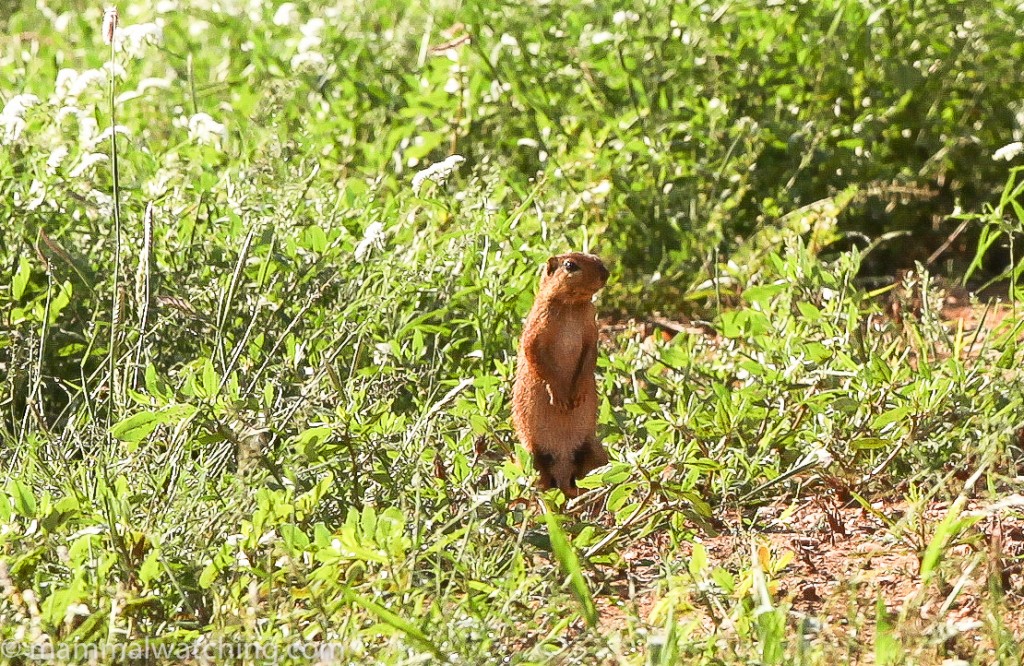
Unstriped Ground Squirrel, Xerus rutilus
The next morning we added several Unstriped Ground Squirrels, but only after 8am, as well as a Savannah Hare and a Slender Mongoose to our list for the park. So far as I could tell Desert Warthogs – a species I should have seen at Ishaqbini had I been able to cross the Tana River – are usually common here. We spent several hours looking without success. The heavy rains had sent the Warthogs to higher ground I think.
Aberdare National Park
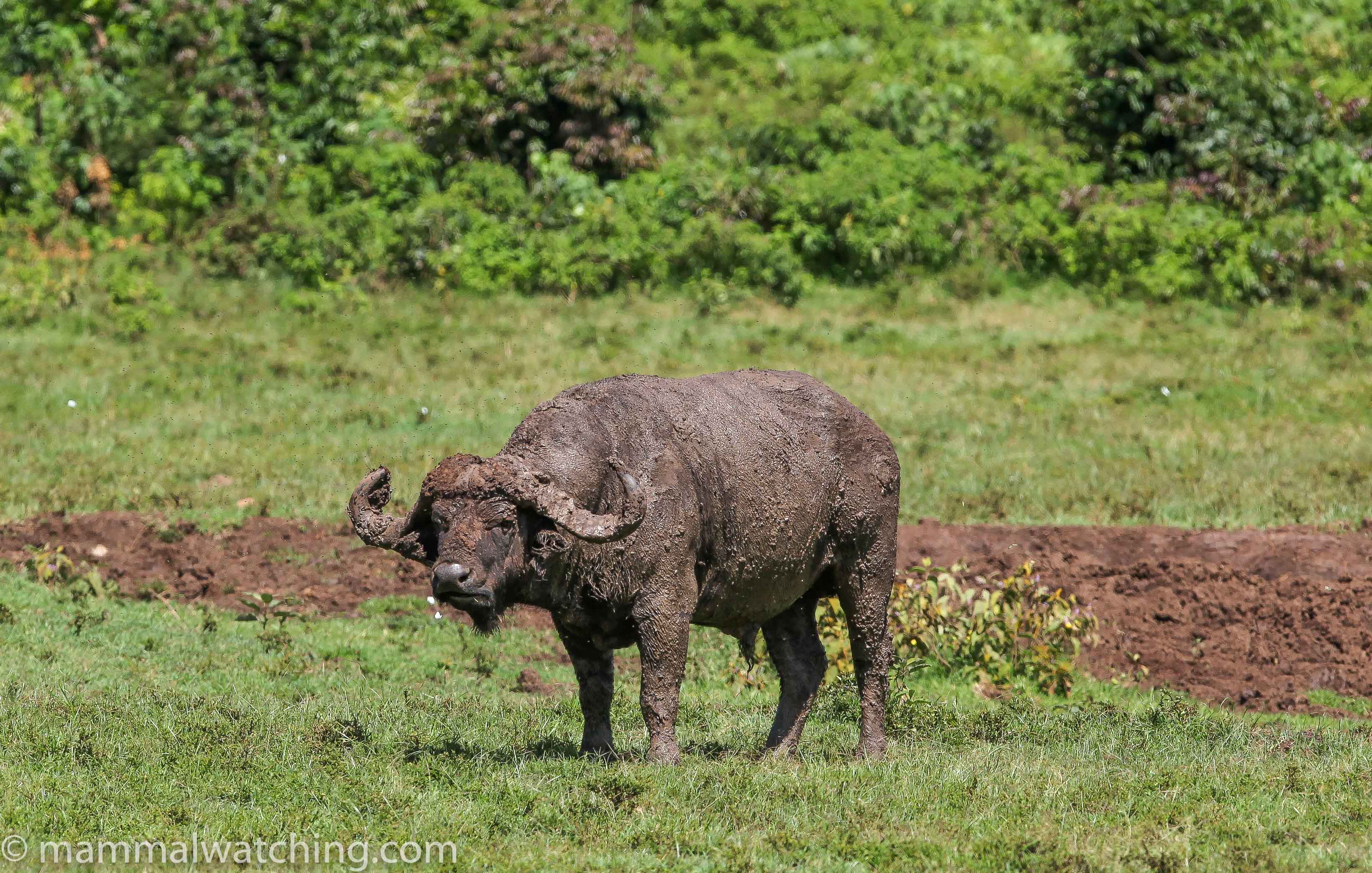
African Buffalo, Syncerus caffer
Giant Forest Hog was top of my want list for Kenya, more than ever after having dipped on this species at Dzanga Sangha where I’d spent the preceding fortnight. From what little information I had gleaned off of the internet I had decided to spend a night on Mt Kenya: the pigs seem quite often reported from some of the lodges there. But after talking to John and Juma I decided to try to visit Aberdare National Park and try to make time to spend 2 nights there. They had both seen Giant Forest Hogs there many many times. Both had seen Bongos there too – and more than once – though admittedly they had visited many times. Visiting Aberdare’s proved to be a very good decision.
Aberdare National Park ranges from about 6,000 to 11,000 ft and is a mixture of rainforest, turning to bamboo then moorland as you climb. It is less than 3 hours drive from Nairobi. There are two largish lodges within the park: the Ark where Richard Webb stayed in 2005 and scored a Giant Forest Hog; and Treetops of which I know nothing other than its where Britain’s Princess Elizabeth was staying when she became Queen. There is also a public campsite within the park, while the Aberdare Country Club is just outside (which is reputed to be a great place to see Eastern Tree Hyrax). There are some smaller private camps too.
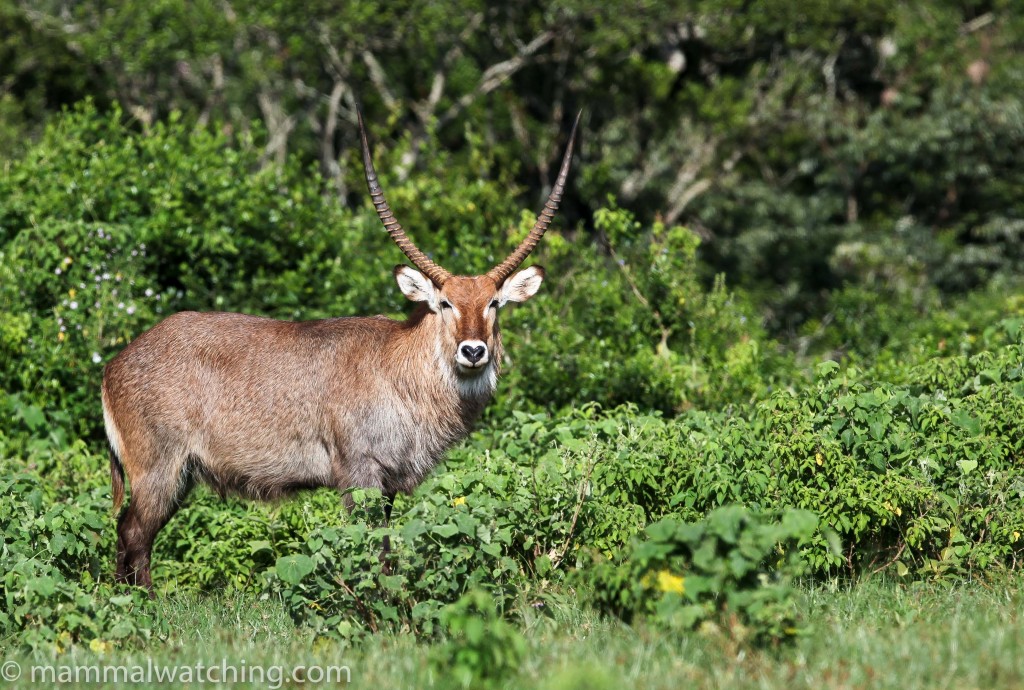
Waterbuck, Kobus ellipsiprymnus
Back in Australia the thought had crossed my mind to stay in the Ark. But when I looked on the internet it appeared to cost $500 a night. So before entering the park to set up camp for the first night I visited the Aberdare Country Club to ask about staying at The Ark (the two hotels share the same management). I was offered a room for $100 full board (at the Kenyan resident’s rate even though he knew full well I wasn’t a resident). I made a tentative booking for the next day and we entered the park.
Our campsite was next to the Ruhuruini Gate, on the edge of an area that now appears to be the best Bongo habitat. It wasn’t easy getting good information on where to look for Bongos. But I learnt the following after talking to a few people: it has been several years since they were seen at the Ark and I think the best bet would be to focus on the moorland at 10,000 ft and above. Indeed, just 3 days before I arrived one of the rangers had seen one near the Queen Elizabeth cave (the cave she was having lunch in when she learnt she had become Queen).
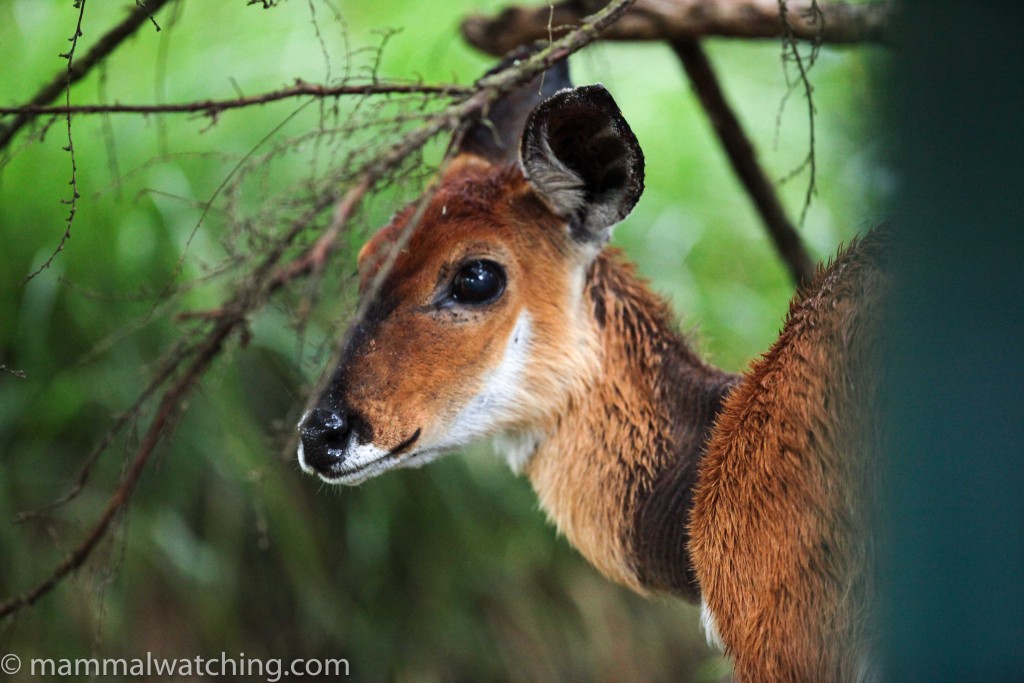
Southern Bushbuck, Tragelaphus sylvaticus
The core area of rainforest in the park is known as the Salient and this seems to be the best patch for Giant Forest Hogs. John the driver said they were pretty much guaranteed and he knew many small clearings to check. We couldn’t find any lower down the road so we moved up to nearer our campsite. At 5pm I saw a pair just off the road. Fifteen minutes later a huge beast crossed the track in front of us. Twenty minutes later Juma had another pair feeding out in the open. Three separate sightings in 45 minutes! Can there be a better place on earth to see this spectacular animal?
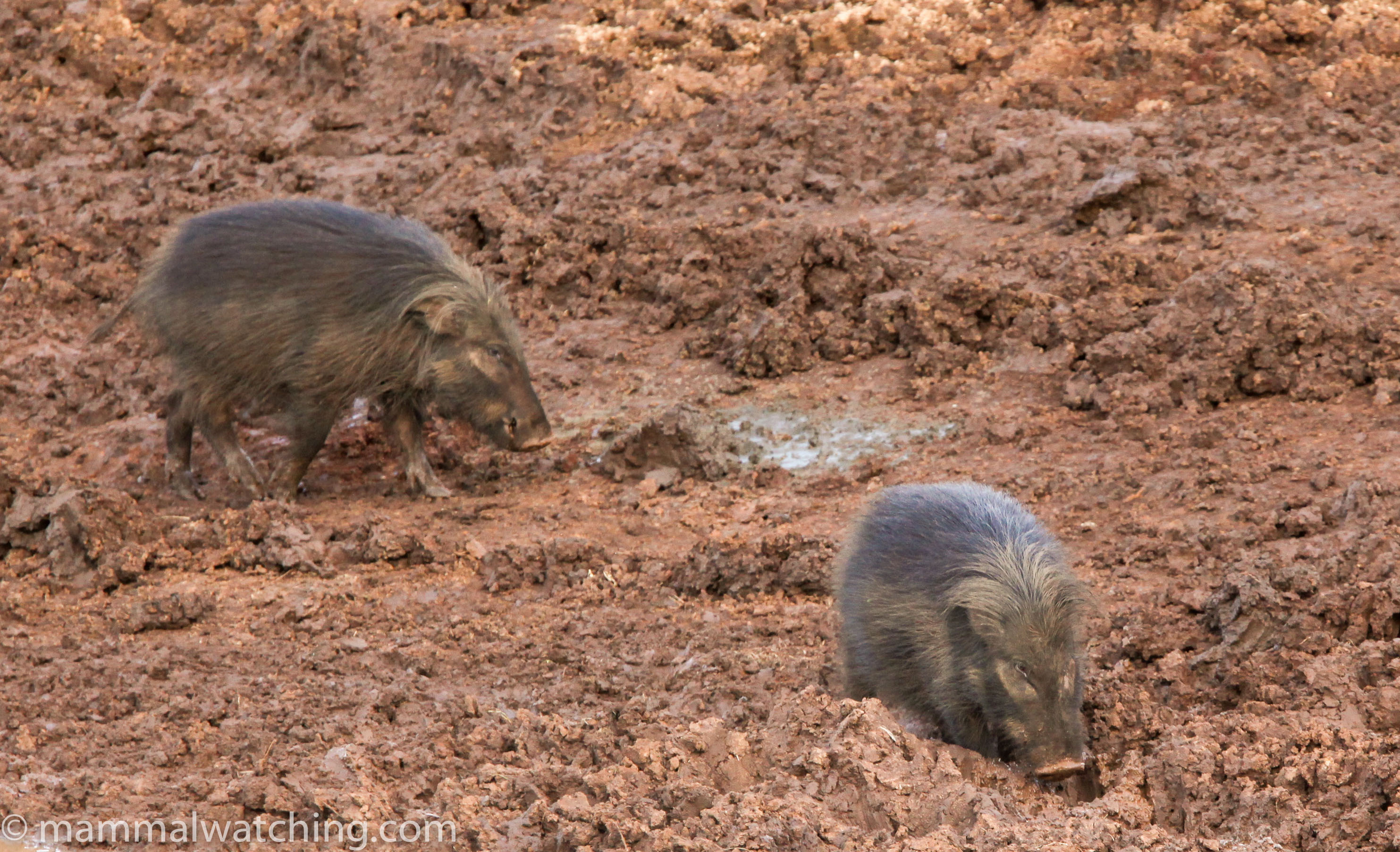
Giant Forest Hogs, Hylochoerus meinertzhageni
Other than the Hogs, we had large numbers of Buffalo, Elephants, Bushbuck, Warthogs and Olive Baboons. We saw a couple of the striking Guerza Colobus from a distance as we drove in, along with some Reedbuck and a Savannah Hare.
Recent heavy rain may have explained why the park was so quiet: we only saw one vehicle and our small campsite was deserted (even the park gate next to it appeared to be unmanned). It was cold up there, which, coupled with the numbers of Buffalos wandering around, put me off going spotlighting. But I couldn’t resist getting out of bed to investigate an Eastern Tree Hyrax calling close by. A quite different call to the orgasmic sounds of the Western Tree Hyrax: the species here sounded like a cross between a frog and a squeaky door. I think the animal was in a not very large tree next to the gate. I was right underneath the tree. The call was at 747 take-off volume. But I couldn’t see the beast.
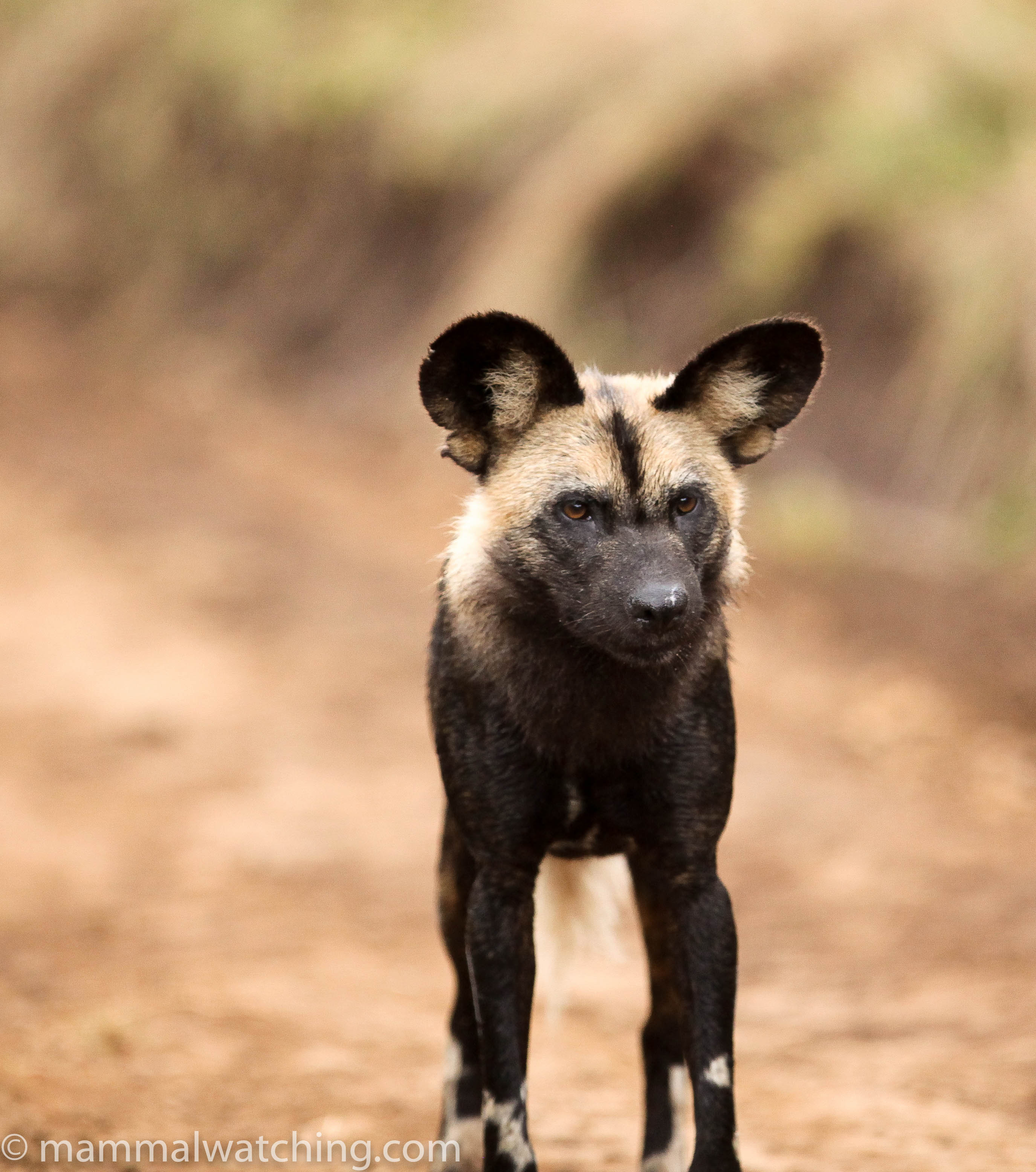
African Wild Dog, Lycaon pictus
A game drive early the next morning took us up into the moorland. We saw all we had seen the day before, plus Waterbuck, minus more Giant Forest Hogs. At 7am, near the Honi Junction, we had 3 Wild Dogs trotting down the road towards us. I asked John to turn off the engine and I squeaked the dogs in to within 2 metres of the car. They looked utterly perplexed by the enormous metal rodent we were sitting in. Neither John nor Juma, who have visited the park at least a hundred times between them, had seen Wild Dogs here so I think this was quite an unusual sighting (probably more unusual than Bongo, not that they were all that much of a consolation to my Bongoless morning).
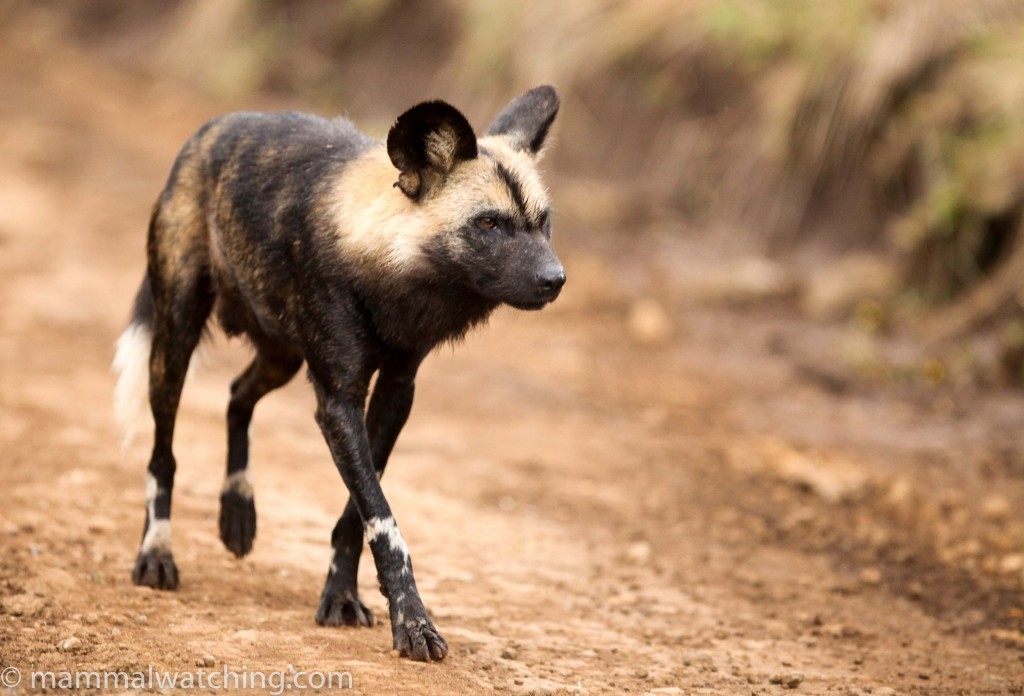
African Wild Dog, Lycaon pictus
Further up in the moorland we saw several Duikers. Some, like the pair below, were Bush Duikers, though I found them hard to tell apart from Harvey’s (Natal Red) Duikers which are also present. But we also had a short but very clear look at another species that must surely have been a Kivu Duiker. We explored the moors until 10am when heavy rain set in. So we returned to camp for a great late breakfast and packed up our stuff.
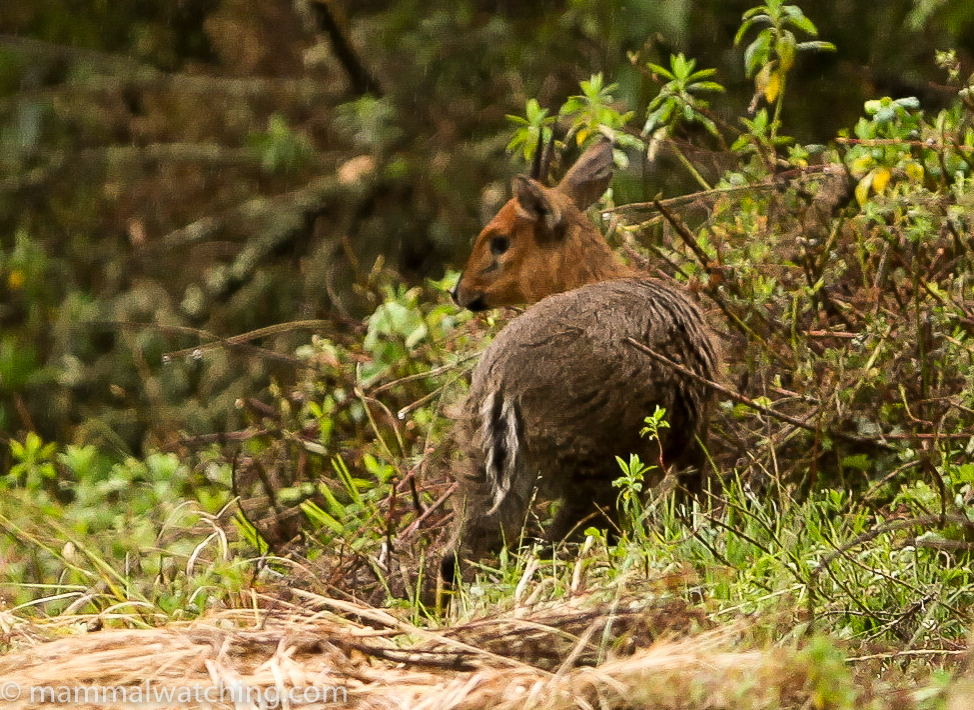
Bush Duiker, Sylvicapra grimmia
I still wanted to a better look at a Giant Forest Hog so decided to spend the night at the Ark. This was another good move.
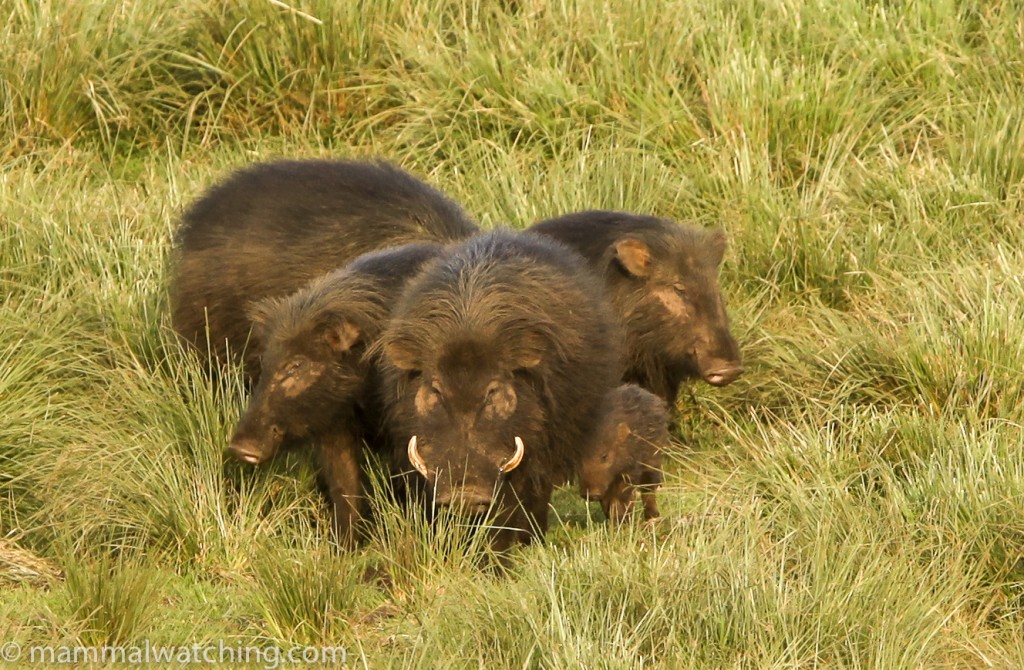
Giant Forest Hogs, Hylochoerus meinertzhageni
The Ark is built overlooking a bai – a natural forest clearing – and guests usually are bussed in from the Country Club after a lunch there, then bussed out again after breakfast the next day. I wanted to spend as little time as possible with the other guests – misanthrope that I am – so preferred to drive myself in, arriving at 4pm in time for afternoon tea and the 5pm bird feeding.
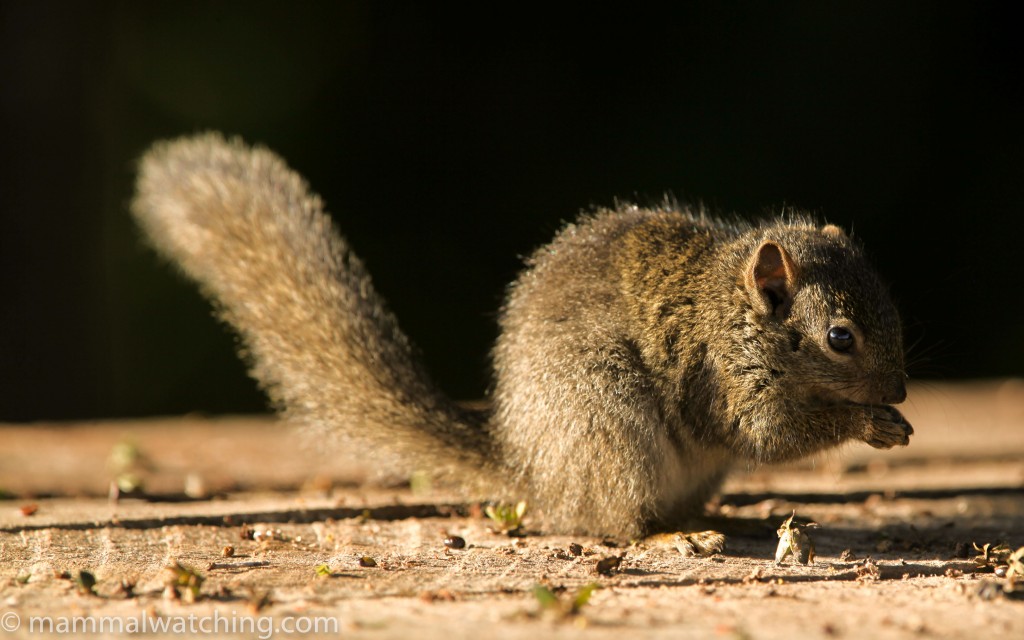
Ochre Bush Squirrel, Paraxerus ochraceus
They have been feeding birds at the Ark for many years and it is not just the birds that come for the food. Ochre Bush Squirrels were very common on and around the bird tables (they were also at the park entrance called the Ark Gate the next morning if you don’t stay there). A pair of Suni showed up under the walkway to eat left left-overs.
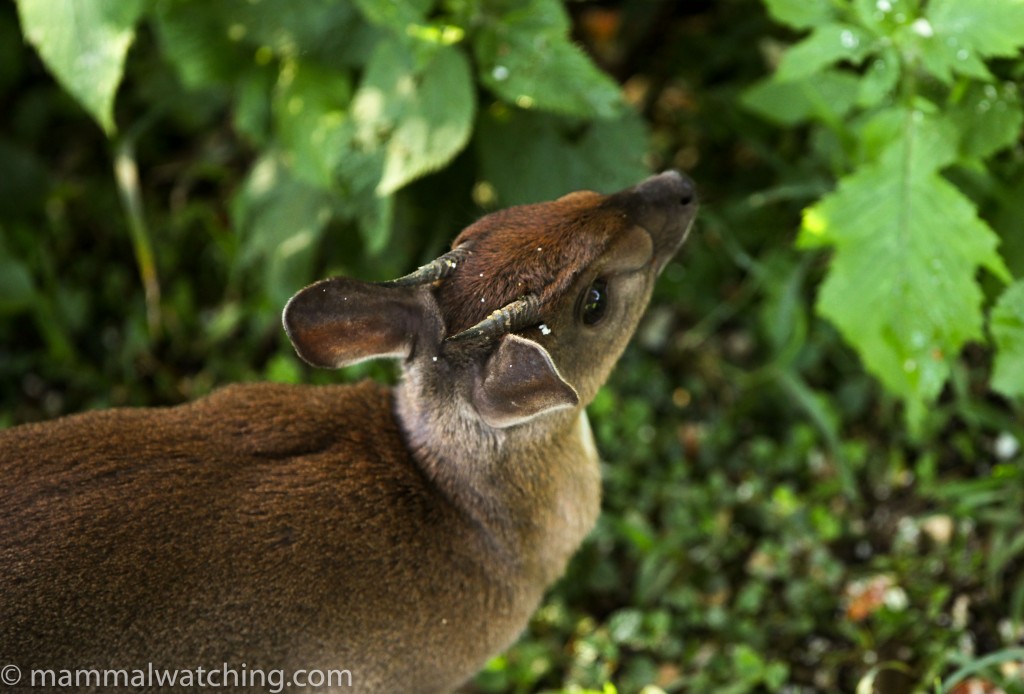
Suni, Neotragus moschatus
The walkway, along with the rest of the outside of the Ark, is out of bounds after dark but I got a leave pass to check out the bird tables after dusk. An enormous – and really quite ugly – East African Giant Pouched Rat was feeding under the table while three Small-eared Galagos had also turned up.
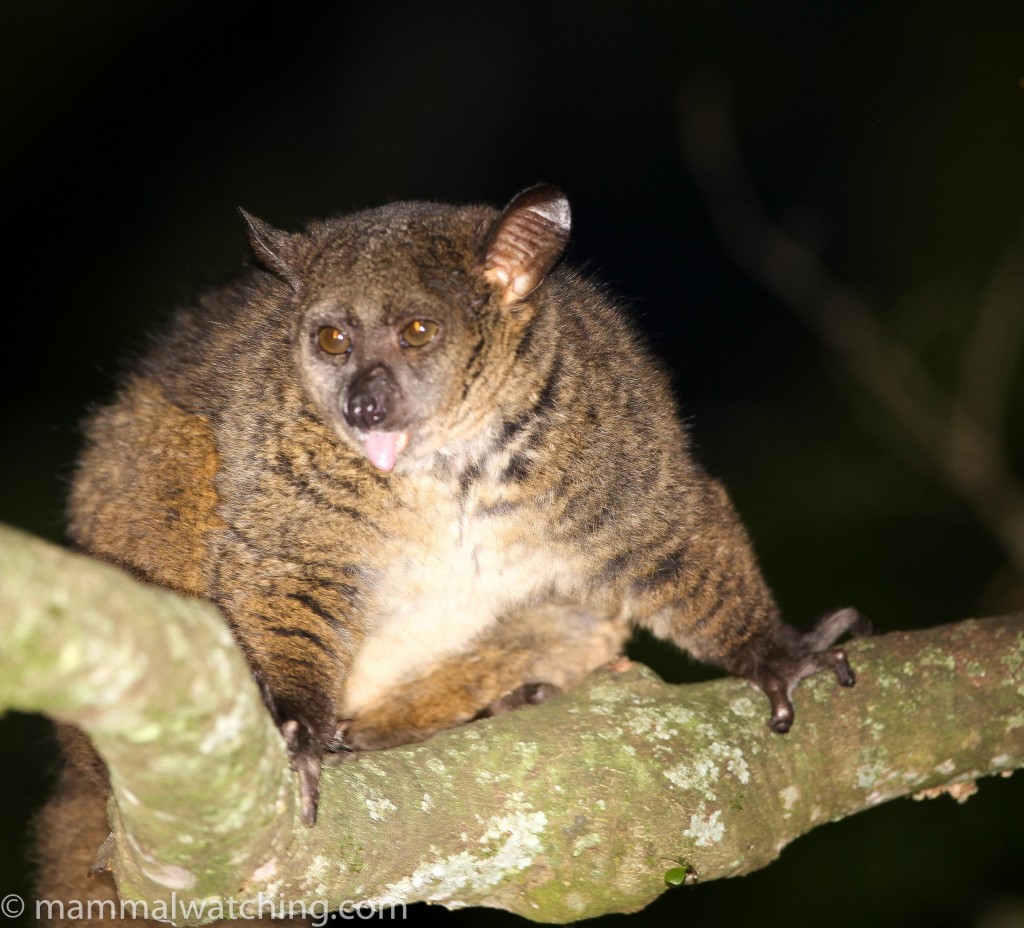
Garnett’s Greater Galago, Otolemur garnettii kikuyuensis
Meanwhile Giant Forest Hogs were on the far side of the bai when I arrived and gradually grew both closer and more numerous. After dinner there were 15 or so at one point. At least two Spotted Hyenas also made an appearance.
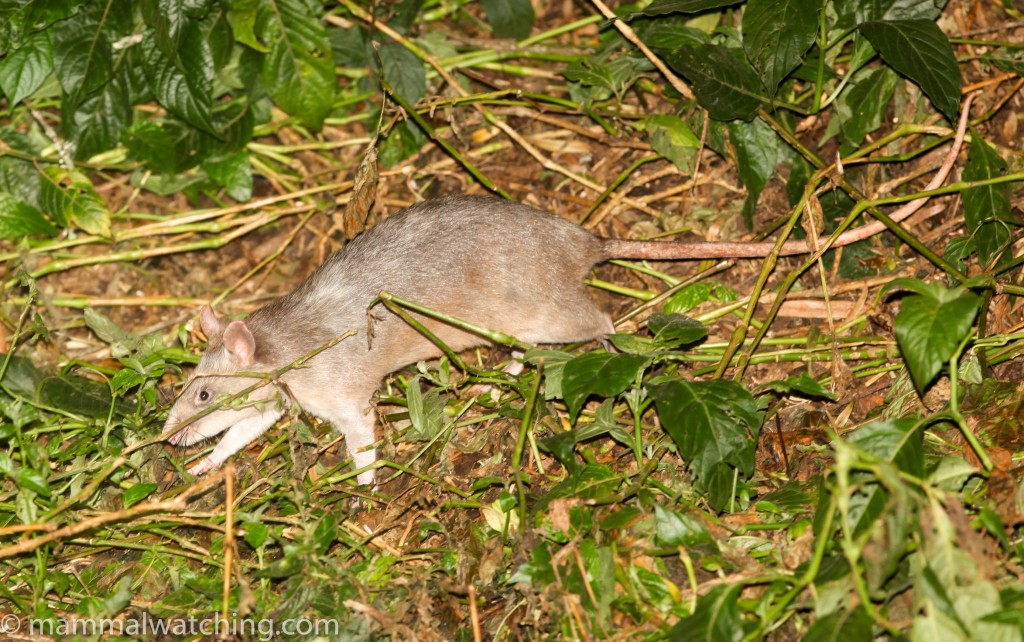
East African Giant Pouched Rat, Cricetomys ansorgei
After dinner a Blotched Genet turned up to be fed on the fire escape, the way it turns up every night. I saw plenty of Elephants, Bushbucks, Buffalo and Warthogs in the Bai while I was at the Ark and heard several fairly distant Tree Hyraxes calling after dark. A White-tailed Mongoose also appeared 3 times during the night though I didn’t see it (staff keep watch and record sightings and sound an optional buzzer to wake you if anything unusual arrives).
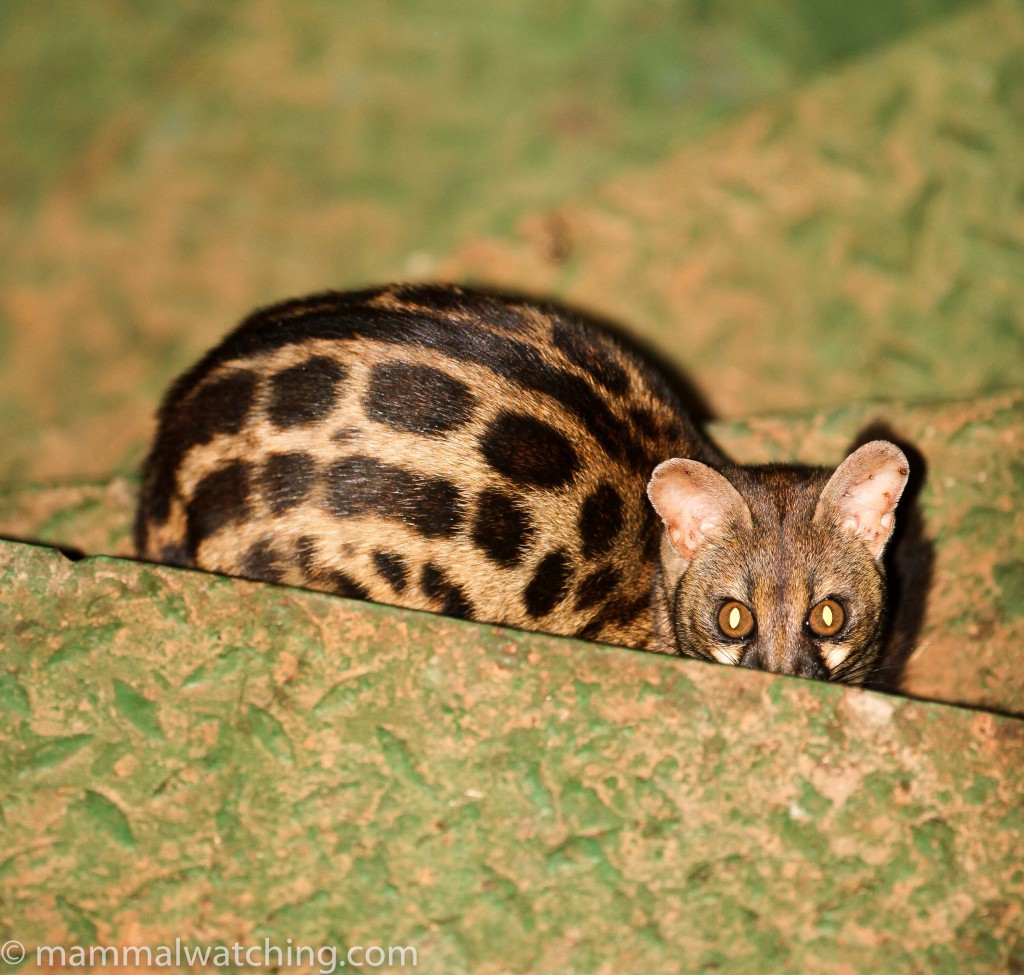
Rusty-spotted Genet, Genetta maculata
Black Rhinos are seen around the ark about once a week, with Leopards and Porcupines not infrequent either.
It seems like some of the more interesting mammals in Aberdare NP are making a comeback. A few years ago the park was used as a dumping ground for problem Lions and they appear to have a big impact on the Bongos and Giant Hogs among other species. The Lions have largely been exterminated now so hopefully the Bongos, like the Giant Forest Hogs, will recover.
After stopping to look at two juvenile Spotted Hyenas by the side of the road we drove back to Nairobi the next morning to catch my afternoon flight to Zanzibar after dealing with Nairobi’s terrible traffic.
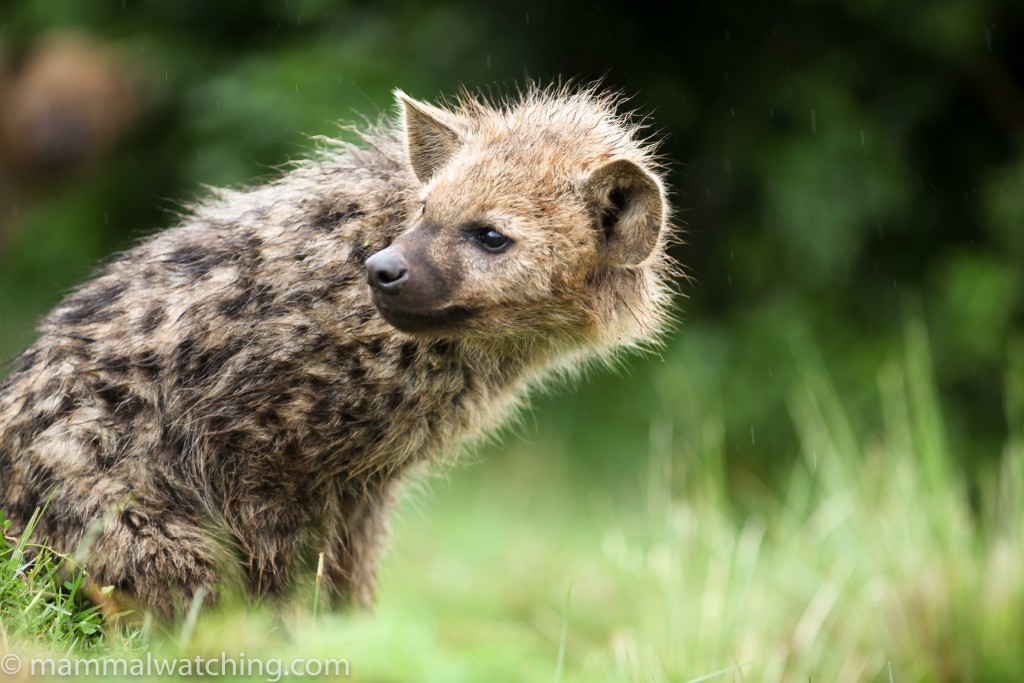
Spotted Hyena, Crocuta crocuta
Nairobi National Park
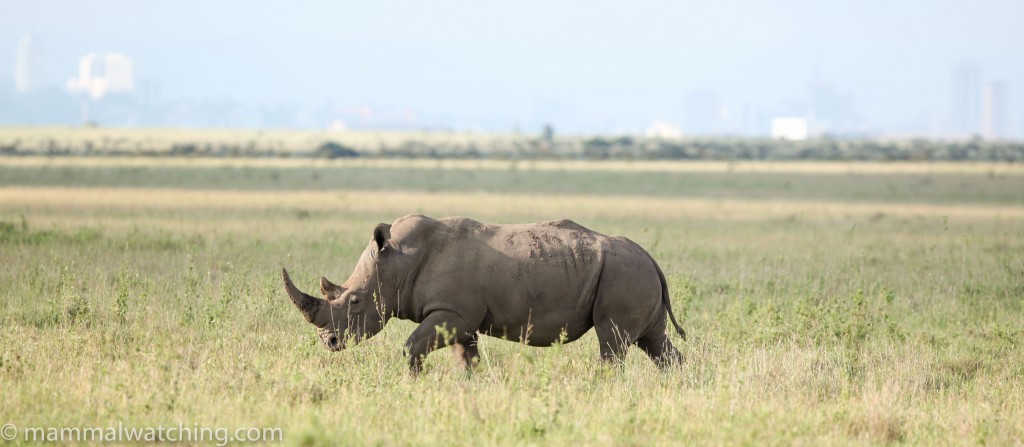
White Rhinoceros, Ceratotherium simum
After a few days in Tanzania I was back in Nairobi and had 12 hours to kill before my flight to France. So I visited Nairobi National Park in a Landcruiser (a vehicle we needed for many of Nairobi’s roads let alone the park!). It was driven by Julius Muriuki a friendly local guide.
As Bob Berghaier noted in his 2008 report it is extraordinary to have such a substantial park on the very edge of a major city. I wasn’t quite as successful as Bob in my haul – the rains and length of the grass in November meant the game viewing was less than optimal – but we did see both of my target species:
Striped Ground Squirrel which took a little effort to find in the middle of the day but we eventually got one running across the road near the KWS camp and workshop inside the park; and
Thomson’s Gazelle, there were small numbers of these out on the plains.
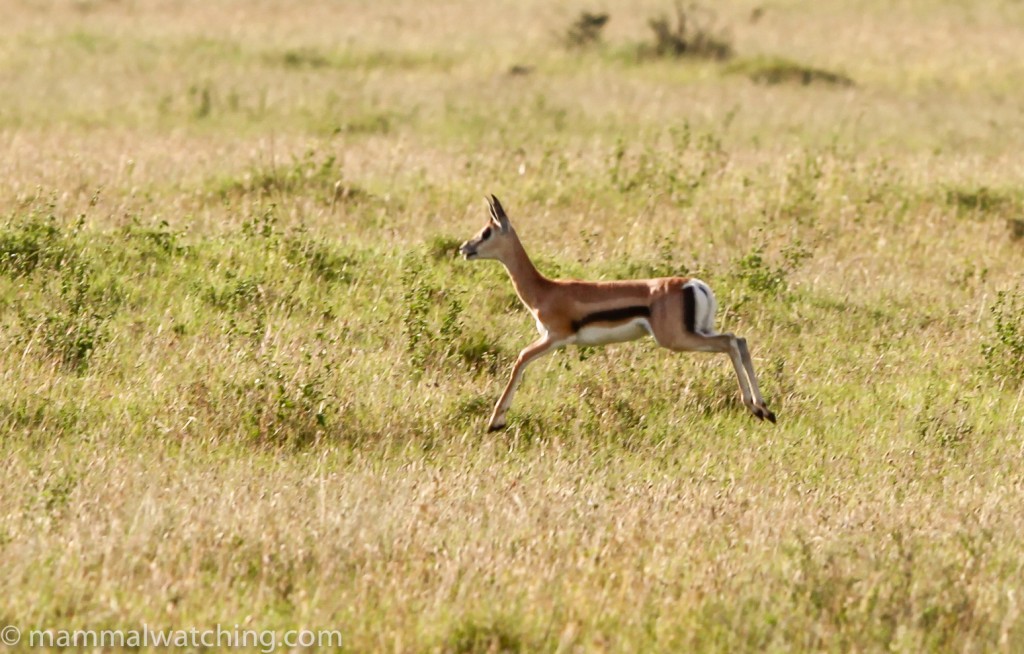
Thomson’s Gazelle, Gazella thomsonii
In a full afternoon in the park we also saw a couple of White Rhino, a few Eland, Masai Giraffe, Olive Baboons and Warthogs along with many Buffalo, Red Hartebeest, Plains Zebra, Grant’s Gazelle and Impala. We also saw an Ochre Bush Squirrel, a couple of Kirk’s Dikdiks and a Slender Mongoose.
Trip List
(F indicates the first time I’ve seen this mammal)
F Golden-rumped Elephant-Shrew Rhynchocyon chrysopygus
African Savanna Hare Lepus victoriae
F Striped Ground Squirrel Xerus erythropus
F Unstriped Ground Squirrel Xerus rutilus
Red-bellied Coast Squirrel Heliosciurus rufobrachium
Ochre Bush Squirrel Paraxerus ochraceus
Red Bush Squirrel Paraxerus palliatus
F East African Giant Pouched Rat Cricetomys ansorgei
Common Genet Genetta genetta
Rusty-spotted Genet Genetta maculata
African Civet Civettictis civetta
Common Slender Mongoose Herpestes sanguineus
Dwarf Mongoose Helogale parvula
White-tailed Mongoose Ichneumia albicauda
Spotted Hyena Crocuta crocuta
African Wild Dog Lycaon pictus
Egyptian Rousette Rousettus aegyptiacus
Mauritian Tomb Bat Taphozous mauritianus
F African Sheath-tailed Bat Coleura afra
F Heart-nosed Bat Cardioderma cor
F Garnett’s Greater Galago Otolemur garnettii
Guereza Colobus Colobus guereza
F Tana River Red Colobus Piliocolobus rufomitratus
Olive Baboon Papio anubis
Yellow Baboon Papio cynocephalus
F Tana River Mangabey Cercocebus galeritus
Blue (Sykes’s) Monkey Cercopithecus mitis albogularis
Vervet Monkey Chlorocebus pygerythrus
F Giant Forest Hog Hylochoerus meinertzhageni
Warthog Phacochoerus africanus
Giraffe Giraffa camelopardalis
Masai Giraffe Giraffa tippelskirchi
Grant’s Gazelle Nanger granti
Bright’s Gazelle Nanger notatus
F Thomson’s Gazelle Gazella thomsonii
F Gerenuk Litocranius walleri
F Guenther’s Dik-dik Madoqua guentheri
F Hinde’s Dik-dik Madoqua hindei
Kirk’s Dik-dik Madoqua kirkii
Suni Neotragus moschatus
African Buffalo Syncerus caffer
Southern Bushbuck Tragelaphus sylvaticus
Eland Taurotragus oryx
Bohor Reedbuck Redunca redunca
Waterbuck Kobus ellipsiprymnus
Oryx Oryx beisa
Hartebeest Alcelaphus buselaphus
Impala Aepyceros melampus
Natal Red (Harvey’s) Duiker Cephalophus (harveyi) natalensis
F Kivu Duiker Cephalophus kivuensis
Bush Duiker Sylvicapra grimmia
Burchell’s Zebra Equus burchellii
F Grevy’s Zebra Equus grevyi
White Rhinoceros Ceratotherium simum
African Savanna Elephant Loxodonta africana
56 species
Stuff I Missed
I didn’t miss a great deal that I was hoping for. A Senegal Galago and Crested Porcupine would have been nice but they are not so hard to see with a little more time. I made no effort to see the Sokoke Dog Mongoose, finding out too late that it is findable, as is Ader’s Duiker which I subsequently saw on Zanzibar. I didn’t hold out much hope of a Bongo but they are in Aberdare NP and there numbers seem to be increasing so maybe in a few years they will be easier there. My priority – when I return to Kenya – will be to see the Hirolas and Desert Warthogs on the other side of the Tana River. I must thank Charles Foley, the guys at Indri/Rockjumper and Bryan Finch for their advice.
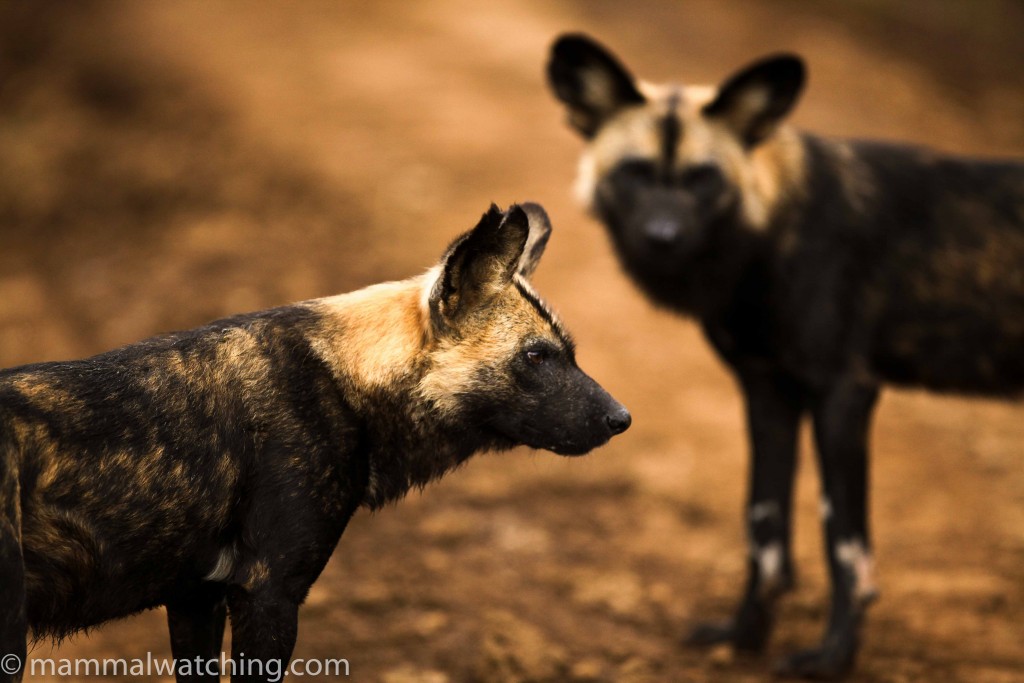
African Wild Dog, Lycaon pictus, Aberdare National Park


Leave a Reply
You must be logged in to post a comment.